- Home
- About
- Map
- Trips
- Bringing Boat West
- Migration West
- Solo Motorcycle Ride
- Final Family XC Trip
- Colorado Rockies
- Graduates' XC Trip
- Yosemite & Nevada
- Colorado & Utah
- Best of Utah
- Southern Loop
- Pacific Northwest
- Northern Loop
- Los Angeles to NYC
- East Coast Trips
- Martha's Vineyard
- 1 Week in Quebec
- Southeast Coast
- NH Backpacking
- Martha's Vineyard
- Canadian Maritimes
- Ocracoke Island
- Edisto Island
- First Landing '02
- Hunting Island '02
- Stowe in Winter
- Hunting Island '01
- Lake Placid
- Chesapeake
- Provincetown
- Hunting Island '00
- Acadia in Winter
- Boston Suburbs
- Niagara Falls
- First Landing '99
- Cape Hatteras
- West Coast Trips
- Burning Man
- Utah Off-Roading
- Maui
- Mojave 4WD Course
- Colorado River Rafting
- Bishop & Death Valley
- Kauai
- Yosemite Fall
- Utah Off-Road
- Lost Coast
- Yosemite Valley
- Arizona and New Mexico
- Pescadero & Capitola
- Bishop & Death Valley
- San Diego, Anza Borrego, Joshua Tree
- Carmel
- Death Valley in Fall
- Yosemite in the Fall
- Pacific Northwest
- Utah Off-Roading
- Southern CA Deserts
- Yosemite & Covid
- Lake Powell Covid
- Eastern Sierra & Covid
- Bishop & Death Valley
- Central & SE Oregon
- Mojave Road
- Eastern Sierra
- Trinity Alps
- Tuolumne Meadows
- Lake Powell Boating
- Eastern Sierra
- Yosemite Winter
- Hawaii
- 4WD Eastern Sierra
- 4WD Death Valley +
- Southern CA Deserts
- Christmas in Tahoe
- Yosemite & Pinnacles
- Totality
- Yosemite & Sierra
- Yosemite Christmas
- Yosemite, San Diego
- Yosemite & North CA
- Seattle to Sierra
- Southwest Deserts
- Yosemite & Sierra
- Pacific Northwest
- Yosemite & South CA
- Pacific Northwest
- Northern California
- Southern Alaska
- Vancouver Island
- International Trips
- Index
- Tips
- Books
- Photos/Videos
- Search
- Contact
Galapagos - Santiago Island
Sunday, March 19, 2023 - 8:15am by Lolo0 miles and 0 hours from our last stop - 1 night stay
Travelogue
 Puerto Egas beachWe slept through another overnight cruise south to the island of Santiago, a somewhat barren island with mostly volcanic landscape.
Puerto Egas beachWe slept through another overnight cruise south to the island of Santiago, a somewhat barren island with mostly volcanic landscape.
Originally named James Island, Santiago was the second of the Galapagos Islands visited by Charles Darwin in 1835. The island had already long been a source of freshwater, wood, and tortoises for buccaneers and whalers for two centuries.The easy-to-catch Giant Tortoises that lived here became a useful source of protein for the sailors. Between 1784 and 1860, whalers took more than 100,000 tortoises from the Galapagos islands, which they kept alive on their ships until ready to eat them
 Puerto Egas beachToday, it’s only visitors are tourists, like us.
Puerto Egas beachToday, it’s only visitors are tourists, like us.
After breakfast, we hopped aboard the pangas for a wet landing on Puerto Egas where there was a lovely sand lava beach. As with every other morning, we were the first tour group ashore, and as a result we had the place to ourselves, except, of course, for the marine iguanas happily breakfasting on the exposed algae bed.
We were allowed to run free in either direction - although Galapagos rules required that tourists always remain in sight of their naturalist guide.
 Sally LightfootI, and most of our group, headed right towards a beautiful, volcanic rock formation just beginning to catch the morning light. Herb, who prefers to photograph in smaller groups, headed to the left, where he happily had the sally lightfoot crabs and marine iguanas all to himself.
Sally LightfootI, and most of our group, headed right towards a beautiful, volcanic rock formation just beginning to catch the morning light. Herb, who prefers to photograph in smaller groups, headed to the left, where he happily had the sally lightfoot crabs and marine iguanas all to himself.
The tide was still low enough to go around the backside of the rock formation to an arch, through which there was a lovely view of Sally Lightfoot crabs scurrying along the tidal pools and a brown pelican posing in the distance.
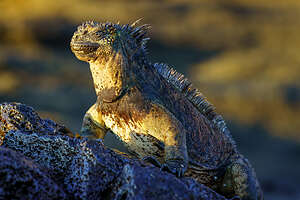 Marine Iguana greeting the sunMeanwhile, Herb was off by himself at the other end of the beach photographing the beautiful bright red, yellow and blue Sally Lightfoods crabs scampering along the lava rocks just above the surf.
Marine Iguana greeting the sunMeanwhile, Herb was off by himself at the other end of the beach photographing the beautiful bright red, yellow and blue Sally Lightfoods crabs scampering along the lava rocks just above the surf.
They are named for their nimble, “light-footed” motion, up and down and even upside down while scurrying across the rocks. It is rumored that the “Sally” part of their name comes from a Caribbean dancer that displayed a similar exceptional agility when she danced.
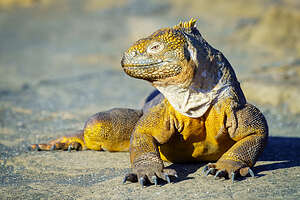 Re-introduced juvenile land iguanaThey would often scoot away when approached, but if you are patient enough and just sit quietly, they will come back out of their hiding place and approach you.
Re-introduced juvenile land iguanaThey would often scoot away when approached, but if you are patient enough and just sit quietly, they will come back out of their hiding place and approach you.
Unlike the flamboyantly colored parents, the juveniles are black, camouflaging them from predators, such as shorebirds, until they develop the speed and agility used by their parents to scoot out of danger.
If someone had told me before this trip that one of our favorite creatures to photograph would be a crab, I would have thought they were crazy, but then we met the Sally Lightfoot crab, and it was love at first sight.
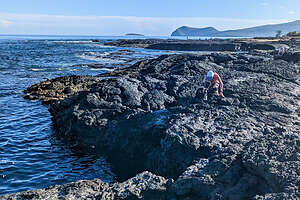 Rocky volcanic shorelineHerb also found a marine iguana soaking up the first morning rays of the sun. They are cold-blooded and need to absorb the heat from the sun to warm up. They are found much of the day, angling their body to directly face the sun, as if worshiping the sun god.
Rocky volcanic shorelineHerb also found a marine iguana soaking up the first morning rays of the sun. They are cold-blooded and need to absorb the heat from the sun to warm up. They are found much of the day, angling their body to directly face the sun, as if worshiping the sun god.
Herb often does the same.
Herb would have happily stayed there for hours, if Monica hadn’t yelled to him that it was time to move on.
 Beautifully patterned stingrayWe left the beach and followed a trail inland through a break in the low ledge adjacent to the sea. Off to the left were the remains of a salt mine from the 1930s, owned by a man named Jorge Egas, hence the name Puerto Egas.
Beautifully patterned stingrayWe left the beach and followed a trail inland through a break in the low ledge adjacent to the sea. Off to the left were the remains of a salt mine from the 1930s, owned by a man named Jorge Egas, hence the name Puerto Egas.
Today, all that remains are some half-ruined buildings and an old soccer field, which has been designated by the National Park Service as one of the only few areas outside of the cities where ship crews are allowed to freely disembark and play for a few hours, to blow off steam from dealing with all those crazy tourists.
 Prehistoric-looking marine iguanaWe met a cute little land iguana along the way.
Prehistoric-looking marine iguanaWe met a cute little land iguana along the way.
Land iguanas had been extinct on Santiago Island since the early 20th century, when feral cats and goats were introduced to the island, killing off many juveniles.
However, after these invasive species were eradicated, in 2019, land iguanas were reintroduced to the island. They were moved from North Seymour island (where we first saw them) where there were over 5,000 of them, too many for the available food on the island. A win-win situation for the two islands.
Three years later, a new generation of newborn and juvenile iguanas are thriving, and today we got to meet one.
 Yellow-crowned night heronThe trail eventually led out onto a rocky volcanic formation along the shoreline with a deep pool informally known as “Darwin’s Toilet, because it fills and empties rapidly with seawater rushing in from underground tunnels.
Yellow-crowned night heronThe trail eventually led out onto a rocky volcanic formation along the shoreline with a deep pool informally known as “Darwin’s Toilet, because it fills and empties rapidly with seawater rushing in from underground tunnels.
We saw a poor sea lion down in the pool that had a fishing line wrapped around his head with the hook still caught in his mouth. There was nothing anyone could do to help him. The rules are very strict in the Galapagos about interfering with the animals in any way. Plus sea lions have very large teeth and have been known to bite and even hospitalize good Samaritans that try to come to their aid.
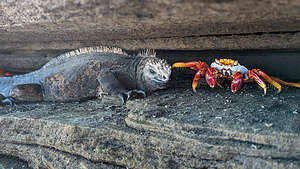 Feisty Sally Lightfoot poking a Marine IguanaFrom the rocks we spotted a stingray with a beautiful pattern on its fins and a large marine iguana swimming in the sea.
Feisty Sally Lightfoot poking a Marine IguanaFrom the rocks we spotted a stingray with a beautiful pattern on its fins and a large marine iguana swimming in the sea.
The diet of marine iguanas is primarily green and red algae. While females and smaller marine iguanas feed intertidally on exposed rocks, the larger males forage on the bottom of the sea. They are the only lizards in the world that are capable of doing this. The bigger males are great divers that can slow their metabolism down to stay submerged for up to an hour.
 Snorkeling time!Their blunt snouts make it easier to nibble the thin layer of red and green algae found on the rocks.
Snorkeling time!Their blunt snouts make it easier to nibble the thin layer of red and green algae found on the rocks.
Over the next few days, and even snorkeling with them, they started to grow on me. Maybe they were kind of cute in their own way.
We also met a yellow-crowned night heron, very much awake, unlike the one we saw yesterday on Genovesa.
 Hieroglyphic HawkfishNext, we came upon some more Sally Lightfood crabs tucked into the cracks of the rocky ledges that lined our path. They seemed perfectly at home with the marine iguanas that joined them. In fact, one feisty Sally Lightfoot seemed to taunt a marine iguana by poking him in the side of his head. The bright red, yellows, and blues of the crab next to the deep black of the marine iguana made for a stunning contrast.
Hieroglyphic HawkfishNext, we came upon some more Sally Lightfood crabs tucked into the cracks of the rocky ledges that lined our path. They seemed perfectly at home with the marine iguanas that joined them. In fact, one feisty Sally Lightfoot seemed to taunt a marine iguana by poking him in the side of his head. The bright red, yellows, and blues of the crab next to the deep black of the marine iguana made for a stunning contrast.
I love watching and photographing the way the species interact with each other so casually - vulture ground finches riding on the back of marine iguanas, colorful reef fish nibbling at the algae on sea turtles, and these Sally Lighfood crabs teasing the marine iguanas.
 Fiddler CrabWhat an incredible morning it had been, and it was only 9:00 a.m.
Fiddler CrabWhat an incredible morning it had been, and it was only 9:00 a.m.
We returned to the boat, got on our wetsuits, and headed back out on the pangas for our daily snorkeling.
One of the strangest fish we saw just lying there hiding amongst some rocks was a hieroglyphic hawkfish, dressed in complete camo garb of stripes and bands, which actually do look a little like hieroglyphics. He just hangs out disguised in the rocks, waiting for dinner to come by. There were also schools of colorful fish, including the pin-striped group, which I was unable to identify.
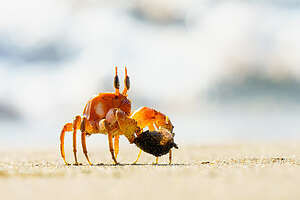 Ghost CrabAfter an hour of snorkeling, we went back to the boat for lunch and a siesta. Free time at last! Herb napped, and I finally got a chance to just sit in an upper deck lounge chair and read a book. However, I must confess I did close my eyes for a bit.
Ghost CrabAfter an hour of snorkeling, we went back to the boat for lunch and a siesta. Free time at last! Herb napped, and I finally got a chance to just sit in an upper deck lounge chair and read a book. However, I must confess I did close my eyes for a bit.
Fed and rejuvenated, we headed back out on the pangas for a landing on Playa Espumilla, a golden sandy beach where every year female sea turtles come in early March to nest.
We saw several of their nests, which were deep, wide holes dug into the sand up near the mangroves, but unfortunately they were empty.
 Dolphins joining us on our panga rideHowever, one lucky person in our group did see a tiny baby one crawl across the beach and successfully make it to the sea. Someday he would return to this very same beach to nest.
Dolphins joining us on our panga rideHowever, one lucky person in our group did see a tiny baby one crawl across the beach and successfully make it to the sea. Someday he would return to this very same beach to nest.
Beyond the beach there was a trail that led through a grove of mangroves to a saline lagoon. Alongside the lagoon we found several collections of sea turtle bones. We also found two new interesting crabs: the fiddler and the ghost.
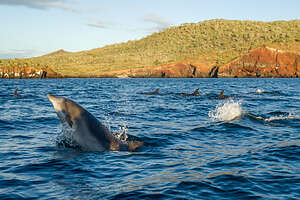 Our dolphin escortsLike the fiddler crabs we have seen in South Carolina, the male has a giant claw which he carries around like a cello - so I nicknamed him Yo-Yo Ma. During courtship, he waves it around to attract females - the fiddler crab that is, not Yo-Yo Ma. They’re kind of hard to photograph, because as soon as they feel the vibration of approaching footsteps, they quickly disappear into their sand burrows.
Our dolphin escortsLike the fiddler crabs we have seen in South Carolina, the male has a giant claw which he carries around like a cello - so I nicknamed him Yo-Yo Ma. During courtship, he waves it around to attract females - the fiddler crab that is, not Yo-Yo Ma. They’re kind of hard to photograph, because as soon as they feel the vibration of approaching footsteps, they quickly disappear into their sand burrows.
The other crab was a Ghost Crab, which Herb was very lucky to photograph, because, as their name implies, they are very elusive and nocturnal. Usually, you only see their tiny eyes at the end of movable stalks peering out from their burrows. Herb got him strutting right out in the open. He looked like a tiny lunar module.
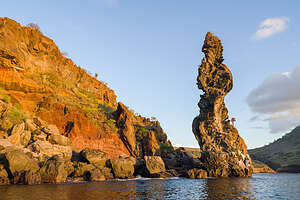 Volcanic cliffs along Buccaneer CoveI can’t believe I am starting to love crabs so much. They are actually quite beautiful when you get up close.
Volcanic cliffs along Buccaneer CoveI can’t believe I am starting to love crabs so much. They are actually quite beautiful when you get up close.
Back out on the beach we met a pair of oystercatchers patrolling the beach for food. Since their food is usually found along the shoreline, they walk rather than fly, and are almost found in pairs.
They are lovely birds with a distinctive black and white plumage, pink legs, and long, bright reddish-orange beaks.
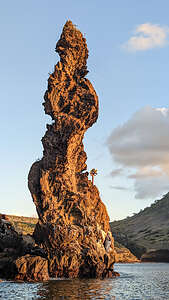 Volcanic Tower with Opuntia cactusTheir diet consists of bivalves, mollusks, worms, and crustaceans which they dig out using their perfectly adapted strong and powerful beaks. Once in their grasp, they pry open their catch with their beak and quickly slice the strong adductor muscles to get at the meat inside.
Volcanic Tower with Opuntia cactusTheir diet consists of bivalves, mollusks, worms, and crustaceans which they dig out using their perfectly adapted strong and powerful beaks. Once in their grasp, they pry open their catch with their beak and quickly slice the strong adductor muscles to get at the meat inside.
Our last activity of the day was a panga ride along the steep cliffs near Buccaneer Cove, with dolphins accompanying us much of the way.
Buccaneer Cove was a haven for pirates and whalers in the 17th and 18th century. When Darwin first visited here in the Beagle in 1835, he found a party of Spaniards drying fish and salt tortoise meat. The island had already been a source of freshwater, wood, and tortoises for buccaneers and whalers for well over a century.
 Post-sunset return to shipThe volcanic cliffs were beautiful, with layers of eroded tuff volcanic rocks forming amazing shapes. They were a stunning red in the late afternoon light.
Post-sunset return to shipThe volcanic cliffs were beautiful, with layers of eroded tuff volcanic rocks forming amazing shapes. They were a stunning red in the late afternoon light.
Many of the cliffs were topped with tall Opuntia cactus. I am always awed with how persistent plants can be to find a home on what was once bare volcanic rock.
By the time we headed back to our boat, the sun was already setting. That’s why we chose this photo tour - first group onshore in the morning, and last to leave at night.
Recap of wildlife we saw today: marine iguanas, Sally Lightfoot crabs, land iguanas, yellow-crested night heron, sea lions, stingrays, hieroglyphic hawkfish (while snorkeling), oystercatchers, fiddler crabs, ghost crabs, and Galapagos mockingbirds.
Galapagos - Genovesa Island
Saturday, March 18, 2023 - 9:00am by Lolo0 miles and hours from our last stop - 1 night stay
Travelogue
 Galapagos Fur SealWhile we slept to the gentle rocking of the boat, our trusty captain made the 8-hour passage north from North Seymour Island to Genovesa (Tower) Island, the northernmost and most remote of the islands we would visit. In fact, sometime during the night, we went over the bump (equator) back into the northern hemisphere.
Galapagos Fur SealWhile we slept to the gentle rocking of the boat, our trusty captain made the 8-hour passage north from North Seymour Island to Genovesa (Tower) Island, the northernmost and most remote of the islands we would visit. In fact, sometime during the night, we went over the bump (equator) back into the northern hemisphere.
Genovesa is known for its abundant birdlife, notably the world’s largest colony of red-footed boobies, with more than 100,000 pairs coming to nest each year.
Oddly, there are no land reptiles on this island, just a few small marine iguanas. This is attributed to the direction of the ocean currents, which wouldn’t have carried terrestrial animals here.
 Swallow-tailed gull and her youngWe woke up (at 4:45 of course) safely anchored in Darwin Bay, inside a volcanic caldera surrounded by cliffs.
Swallow-tailed gull and her youngWe woke up (at 4:45 of course) safely anchored in Darwin Bay, inside a volcanic caldera surrounded by cliffs.
After breakfast, we promptly got into the panga at 5:50 to be dropped off on a small beach where colonies of great frigatebirds and red-footed boobies nest. This was our first wet landing, which meant we had to wear the appropriate footwear (Tevas in my case) because we would not be brought all the way to shore, but close enough to easily get ashore.
 Juvenile booby of sorts?Today we were greeted by one old friend, the adorable fur seal we met yesterday on North Seymour Island, and one new, the lovely swallow-tailed gull.
Juvenile booby of sorts?Today we were greeted by one old friend, the adorable fur seal we met yesterday on North Seymour Island, and one new, the lovely swallow-tailed gull.
I spoke yesterday about the fur seal and how they somewhat inadvertently found their way to the Galapagos Islands during the Ice Age and couldn’t leave when the glaciers melted. However, like all good Galapagos residents, they adapted and learned to cope in a climate not conducive to having a double furry coat of insulation.
The swallow-tail gull is a beautiful bird with a pearly gray and black head, pinkish legs, and a pale-tipped bill with a white spot at the base. When in flight they have a distinctive three-tone wind pattern of gray, white, and black.
 Herb and a very curious Brown NoddyThe ones we saw also had a distinctive red ring around their eyes, which means they are ready to breed. If the ring is black, they are not in the mood. Since they only come to the Galapagos when they are breeding, all of them on Genovesa had the red ring.
Herb and a very curious Brown NoddyThe ones we saw also had a distinctive red ring around their eyes, which means they are ready to breed. If the ring is black, they are not in the mood. Since they only come to the Galapagos when they are breeding, all of them on Genovesa had the red ring.
When swallow-tailed gulls are not breeding, they are totally pelagic, flying and hunting over the open ocean, never once setting their webbed feet on dry land. Although they spend most of their life flying and hunting over the open ocean, when it’s time to breed they come to the Galapagos Islands, particularly the rocky shores and cliffs of Genovesa (Tower), Hood, and Wolf islands.
 Brown Noddy peering in Herb's lensAnother interesting fact about the swallow-tailed gulls is that they are the only fully nocturnal seabird in the world, using their highly developed night vision to prey on squid and small fish which rise to the surface at night to feed on plankton.
Brown Noddy peering in Herb's lensAnother interesting fact about the swallow-tailed gulls is that they are the only fully nocturnal seabird in the world, using their highly developed night vision to prey on squid and small fish which rise to the surface at night to feed on plankton.
Since the Galapagos is a great place to study how animals have evolved over time to cope with their environment, it’s important to point out that their night hunting is a form of adaptive behavior, evolving from the greater abundance of squid and other fish on the surface at night and the necessity of bringing food back safely before the diurnal frigatebird can steal it from them.
 Yellow-crowned night heronFrom the beach, we set off on a 1.5 km trail which would take us inland to the mangroves where the red-footed boobies nest.
Yellow-crowned night heronFrom the beach, we set off on a 1.5 km trail which would take us inland to the mangroves where the red-footed boobies nest.
We didn’t get too far before we met a very social and curious Brown Noddy (or at least I think that’s what he was), who was even more interested in us than we were in him. As Herb knelt down to his eye level, the Noddy actually stuck his beak right into Herb’s lens, which did make for a very interesting perspective. He then started playing with Herb’s camera strap, trying to pull it away from him. He also nibbled on Monica’s toes for a while.
He was so much fun to play with that we found it hard to pull ourselves away. Unlike the non-photo tour groups which tended to just march non-stop along a trail, we would literally spend 2 hours just observing and photographing the wildlife, spreading ourselves out like beads on a necklace with Monica up front and Tui in the rear.
 Male red-footed booby bringing twigs to nestIt was slow-going getting to the mangroves, because we kept seeing so many interesting creatures along the way, such as the nocturnal yellow-crowned night heron, snoozing on a rocky ledge. We were curious about the membrane across his eye, but later learned that many water birds have an extra eyelid, called the nictitating membrane, which provides protection to the eye.
Male red-footed booby bringing twigs to nestIt was slow-going getting to the mangroves, because we kept seeing so many interesting creatures along the way, such as the nocturnal yellow-crowned night heron, snoozing on a rocky ledge. We were curious about the membrane across his eye, but later learned that many water birds have an extra eyelid, called the nictitating membrane, which provides protection to the eye.
Finally, in the mangroves, we got our first sighting of red-footed boobies, with their bright red feet and colorful light blue and pink beak. The ones found in the Galapagos are predominantly brown with a white, belly, rump, and tail. Out of the three booby species in the Galapagos, the red-footed boobies are the smallest.
 Red-footed boobyUnlike the blue-footed boobies who mate and nest right out in the open, often right in the middle of a trail, the red-footed boobies (males) collect twigs and build nests in trees and shrubs. They have longer toes than other boobies which allows them to grasp branches.
Red-footed boobyUnlike the blue-footed boobies who mate and nest right out in the open, often right in the middle of a trail, the red-footed boobies (males) collect twigs and build nests in trees and shrubs. They have longer toes than other boobies which allows them to grasp branches.
They are much more difficult to photograph than the blue-footed boobies because there always seems to be a branch in the way, often hiding their faces and red-feet.
However, we were fortunate enough to photograph a male bringing some twigs back to the nest.
 Frigatebird stealing food from a booby mid-airRed-footed boobies are strong flyers and feed on flying fish and schooling squid far out to sea, often traveling 90 miles out when foraging. They are well adapted for diving, with long bills and aerodynamic bodies.
Frigatebird stealing food from a booby mid-airRed-footed boobies are strong flyers and feed on flying fish and schooling squid far out to sea, often traveling 90 miles out when foraging. They are well adapted for diving, with long bills and aerodynamic bodies.
Many visitors to the Galapagos never get to see this interesting sea bird, because they are only found in the northern, more remote part of the Galapagos archipelago, particularly Genovesa and Punta Pitt on San Cristobal Island where fewer people visit.
 Snorkel Time!On the way back to the panga, we saw two lava gulls nesting on a rocky cliff ledge. They are the second species of gulls on Genovesa, much darker than the swallow-tailed gulls in order to blend better into the lava rocks they nest on.
Snorkel Time!On the way back to the panga, we saw two lava gulls nesting on a rocky cliff ledge. They are the second species of gulls on Genovesa, much darker than the swallow-tailed gulls in order to blend better into the lava rocks they nest on.
However, the most dramatic action we encountered was a frigatebird doing its pirate-thing. As I mentioned in the North Seymour writeup, frigatebirds can’t get wet, because their preen gland doesn’t produce enough oil to waterproof their wings. So, they have to be pirates, surviving by stealing food from other diving birds (usually blue-footed boobies), by grabbing their tail feathers and shaking them violently until they give up their catch.
 Galapagos Sea TurtleWhat an exciting day! Wait a minute, it was only 9:00 am, and we were just getting started. Next up, snorkeling in Darwin Bay.
Galapagos Sea TurtleWhat an exciting day! Wait a minute, it was only 9:00 am, and we were just getting started. Next up, snorkeling in Darwin Bay.
This was to be the first of many snorkeling adventures this trip (one each day and sometimes even two). Herb and I had purchased new 2mm shorty wetsuits for the trip, which turned out to be the perfect thickness for the warm waters of March.
 Rainbow ParrotfishIn order not to lose any clients, the following safety measures were used. The two pangas from our boat would stay out either ends of us, and the panga drivers would constantly count heads, making sure we were all accounted for. Meanwhile, Monica and Tui would be in the water keeping an eye on us as well. Monica even had a lifesaving ring with rope around it to hold onto in case any of us needed a break or had to adjust a facemask. While I didn’t hang onto it, I did pretty much follow Monica around in case I had to.
Rainbow ParrotfishIn order not to lose any clients, the following safety measures were used. The two pangas from our boat would stay out either ends of us, and the panga drivers would constantly count heads, making sure we were all accounted for. Meanwhile, Monica and Tui would be in the water keeping an eye on us as well. Monica even had a lifesaving ring with rope around it to hold onto in case any of us needed a break or had to adjust a facemask. While I didn’t hang onto it, I did pretty much follow Monica around in case I had to.
I had bought a waterproof cover for my phone so that I could take pictures, but it didn’t work very well, so I left Herb in charge of underwater photos. In retrospect, I wish we had a GoPro, like many of the other people on the trip, as videos would have been nice to have.
 Red-billed tropicbird in flightThat day we saw dolphins, sea turtles, sting rays, and very colorful reef fish. The hour passed by before we knew it.
Red-billed tropicbird in flightThat day we saw dolphins, sea turtles, sting rays, and very colorful reef fish. The hour passed by before we knew it.
Then it was back to the mothership where we had a delicious lunch and time for a far too brief nap before heading out on the panga again to climb Prince Philip’s Steps.
Along the way Herb was able to capture a red-billed tropicbird in flight from, which are rarely seen from land, as they nest in the crevices of the rocky cliffs. Adults have a stout red bill and long white tail streamers. They are absolutely beautiful.
The Prince Philip Steps were named in honor of a royal visit to the islands by Queen Elizabeth II’s husband Philip. The steep-railed stairway leads to a dramatic trail along the lava plains atop the cliffs.
 Prince Philip’s stepsAs if we hadn’t already seen such an amazing collection of wildlife today, there was more.
Prince Philip’s stepsAs if we hadn’t already seen such an amazing collection of wildlife today, there was more.
We saw a fuzzy baby chick emerging from its nest (not sure if it was a red-footed or masked booby chick). It looked like it had just been born.
Although we had seen Magnificent frigatebirds on North Seymour, here we came across a tender moment where the male and female are actually cuddling. It’s difficult to see, but the female is resting her head on her mate’s inflated, red throat pouch.
 Marine Iguana giving a Vampire Finch a piggy back rideWe also got to see our first marine iguana with a vampire ground finch on his back. I won’t go into depth now describing the marine iguana’s appearance, behaviors, etc., because we would be seeing much larger populations of them when we visited Fernandina, Floreana, and Espanola; however, the vampire finch was a rare find.
Marine Iguana giving a Vampire Finch a piggy back rideWe also got to see our first marine iguana with a vampire ground finch on his back. I won’t go into depth now describing the marine iguana’s appearance, behaviors, etc., because we would be seeing much larger populations of them when we visited Fernandina, Floreana, and Espanola; however, the vampire finch was a rare find.
Everyone knows about Darwin’s discovery of how finches adapted and evolved differently on each of the Galapagos islands based on the available food source. Well, that’s how the finches on Genovesa became vampires. As seeds and insects are sometimes scarce on the northern islands, these finches evolved to have extremely sharp beaks, which they use to peck at the feathers and skin of Nazca and blue-footed boobies until blood is drawn, which they then drink.
 Galapagos short-eared owlTheir beaks might be sharp, but not sharp enough to penetrate the skin of a marine iguana, so I think he was just going for a joy ride.
Galapagos short-eared owlTheir beaks might be sharp, but not sharp enough to penetrate the skin of a marine iguana, so I think he was just going for a joy ride.
The last bird of an already eventful day was a short-eared owl, a medium-sized brownish bird, only found on Genovesa Island. He was asleep on his perch, although they, unlike other owls, do sometimes hunt during the day. We especially took note of his hairy legs.
What a day! Now it was back to the boat, a briefing as to tomorrow’s activity, dinner, and bed.
Recap of creatures we saw today: fur seals, swallow-tailed gulls, lava gulls, brown noddies (I think), juvenile blue-footed booby (?), red-footed boobies, yellow-crowned night heron, frigatebirds, sea turtles (underwater), red-billed tropicbird in flight, vampire ground finch, marine iguana, and a Galapagos short-eared owl
Galapagos - North Seymour Island
Friday, March 17, 2023 - 2:30pm by Lolo miles and hours from our last stop - 1 night stay
Travelogue
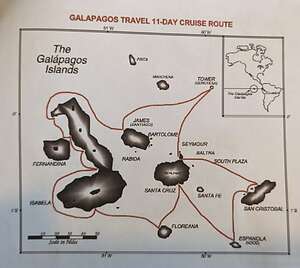 Map of our 11-day cruiseAs I mentioned in the Overview, this was not our first attempt at a “once-in-a-lifetime” trip to the Galapagos Islands. Almost 3 years ago, to the date, on March 12, 2020, we were packed and ready to leave for the airport where we would begin our journey to the Galapagos Islands on a Gate 1 tour.
Map of our 11-day cruiseAs I mentioned in the Overview, this was not our first attempt at a “once-in-a-lifetime” trip to the Galapagos Islands. Almost 3 years ago, to the date, on March 12, 2020, we were packed and ready to leave for the airport where we would begin our journey to the Galapagos Islands on a Gate 1 tour.
Just as we were about to head out the door, something made me check the Gate 1 website, only to discover that the tour, which was to begin in 2 days (we were going early) was canceled. We were so close to actually getting to Ecuador where we would find no tour guide to greet us.
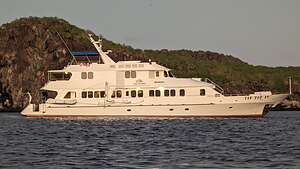 Tip Top IVWe all know what happened over the next 2 years - basically travel stopped while the world waited for the pandemic to end.
Tip Top IVWe all know what happened over the next 2 years - basically travel stopped while the world waited for the pandemic to end.
As things began to open up again, we thought about reimplementing our trip. However, since that time, we had talked to various people and researched other tours and came to the conclusion that the Gate 1 tour (which included only 3 nights on the Galapagos Islands) was not going to be enough.
After much research, Herb came to the conclusion that a longer photography-focused tour made the most sense for us. That’s when he discovered Tui de Roy, the legendary Galapagos photographer that was brought to the Galapagos by her Belgian parents when she was 2 years old. Her father gave her her first camera when she was in her early teens, and she hasn’t stopped photographing the islands since. Over 5 decades and tens of thousands of photos later, she has been awarded a place as one of the top 20 wildlife photographers in the world.
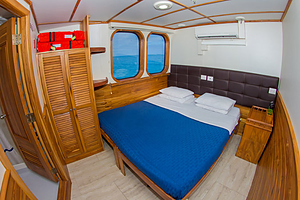 Our cabin on the Tip Top IVWhen Herb found that Tui was the photography guide on a Galapagos Travels 11-day Galapagos Islands tour, we knew we found the tour for us. The opportunity to spend 11 days exploring and photographing this amazing place with the best of the best was very exciting.
Our cabin on the Tip Top IVWhen Herb found that Tui was the photography guide on a Galapagos Travels 11-day Galapagos Islands tour, we knew we found the tour for us. The opportunity to spend 11 days exploring and photographing this amazing place with the best of the best was very exciting.
Our home for the 11 days was the Tip Top IV, a 125-foot yacht which held 15 passengers, 7 crew members, one Naturalist Guide (Monica), and Tui de Roy (Photography Guide). During those 11 days, we would visit 10 different islands, each with its own sometimes overlapping, but often unique, flora and fauna
Day 1 - Arrival and North Seymour Island
This was the big day - our flight to the Galapagos Islands!!!
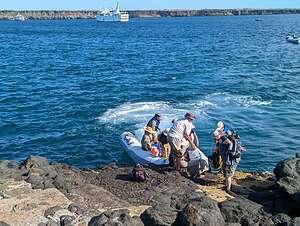 Our first dry landingThere was lots of extra hurdles to go through at the Quito airport to meet the restrictions and security inspections required by the Galapagos National Park, mostly to ensure that we were not bringing anything to the islands that we shouldn’t, specifically, agricultural or plant materials or any unprocessed food products, so as not to affect the unique and pristine ecosystems.
Our first dry landingThere was lots of extra hurdles to go through at the Quito airport to meet the restrictions and security inspections required by the Galapagos National Park, mostly to ensure that we were not bringing anything to the islands that we shouldn’t, specifically, agricultural or plant materials or any unprocessed food products, so as not to affect the unique and pristine ecosystems.
Upon arrival at Baltra airport, we were greeted by Monica, our Naturalist Guide, who we would learn to love over the next 11 days.
Before we knew it, we were transferred by bus to the yacht, which almost immediately lifted anchor and headed to North Seymour Island, officially marking the start of our 11-day Galapagos cruise.
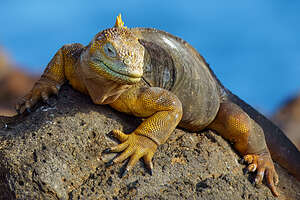 Our first land iguanaWe were shown to our lovely cabin on the upper deck, and barely started unpacking before the bell down below rang, summoning us to come down prepared for our first shore landing. The boat had already moved and anchored off of North Seymour Island white we were trying to unpack.. Wow! These people meant business.
Our first land iguanaWe were shown to our lovely cabin on the upper deck, and barely started unpacking before the bell down below rang, summoning us to come down prepared for our first shore landing. The boat had already moved and anchored off of North Seymour Island white we were trying to unpack.. Wow! These people meant business.
This one was to be a dry landing, meaning the panga would back us right up onto the shore allowing us to get ashore without getting our feet, as opposed to a wet landing where we would have to step into the surf. Both were fine, and we quickly learned to trust the panga drivers and use the “Galapagos handshake” (grasping forearms rather than hands) to get safely on and off the boat.
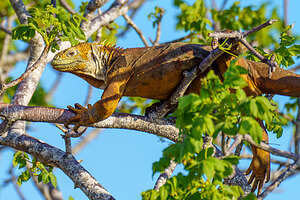 Have to remember to look upAs we got off the panga, I remember wondering if we would see any interesting wildlife. Well, that concern was quickly laid to rest as we were greeted by a Galapagos-style welcoming committee: land iguanas, frigatebirds, and adorable blue-footed boobies. Not only would we see them, but they would approach us like old friends.
Have to remember to look upAs we got off the panga, I remember wondering if we would see any interesting wildlife. Well, that concern was quickly laid to rest as we were greeted by a Galapagos-style welcoming committee: land iguanas, frigatebirds, and adorable blue-footed boobies. Not only would we see them, but they would approach us like old friends.
The first resident of North Seymour that we met was the land iguana, who I came to love as a photo subject, especially because it couldn’t fly away and would happily sit still for me.
In the early 1930s, there were no land iguanas on North Seymour island, but an amateur naturalist named Allan Hancock moved some over from neighboring Baltra Island. They flourished, mostly because the plants on the island had not yet evolved natural defenses against them (evolution at work again). Today there are 2,500 of them on the island.
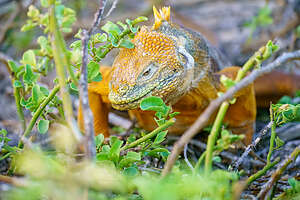 Can't get enough of these land iguanasBy the 1950s, land iguanas had gone extinct on Baltra from U.S. soldiers stationed there during WWII hunting them. The favor was returned and North Seymour iguanas were re-introduced to Baltra.
Can't get enough of these land iguanasBy the 1950s, land iguanas had gone extinct on Baltra from U.S. soldiers stationed there during WWII hunting them. The favor was returned and North Seymour iguanas were re-introduced to Baltra.
Although land iguanas look like scary prehistoric creatures, they are very trusting and docile (when not mating). Plus, they are vegetarians, so they were not interested in me as a lunch entree. Rather they feed on prickly pear cactus, spines and all, which provide them with both food and water.
They are actually quite beautiful (in their own way), about 4 or 5-feet long, with yellow and white bumpy skin and a spiny dorsal crest along their neck and back. They look like they are wearing long-sleeve sweaters that stop at the wrist. Where the sweater ends the very sharp claws on their toes (or hands?) begin.
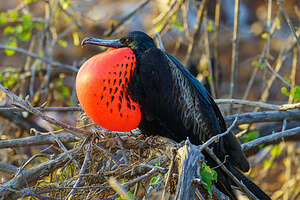 Magnificent FrigatebirdThe other thing I loved about them was that they always seem to have this smirky grin on their face, as if they are more amused about me than I was about them.
Magnificent FrigatebirdThe other thing I loved about them was that they always seem to have this smirky grin on their face, as if they are more amused about me than I was about them.
They are best to photograph at eye level, so I was very glad we brought along knee pads so that we could get down to their level - $20 volleyball pads on Amazon.
Land iguanas are easy to find during the day, because they are cold-blooded and need to absorb heat from the sun by basking on the volcanic rock. At night they crawl into burrows that they have dug to conserve the body heat they have accumulated during the day.
.thumbnail.jpg) Blue-footed boobies beginning their courtship ritualWe actually found one fairly large land iguana up in the upper branches of a tree. I didn’t realize they did that but they certainly have the claws to be good climbers. I have heard about Florida iguanas falling out of trees when the temperature drops because they are cold-blooded and become cold-stunned and lose their grip. Not sure if that happens in the Galapagos, but it would be interesting to photograph, or better yet, video.
Blue-footed boobies beginning their courtship ritualWe actually found one fairly large land iguana up in the upper branches of a tree. I didn’t realize they did that but they certainly have the claws to be good climbers. I have heard about Florida iguanas falling out of trees when the temperature drops because they are cold-blooded and become cold-stunned and lose their grip. Not sure if that happens in the Galapagos, but it would be interesting to photograph, or better yet, video.
As we continued along the trail, it curved away from the shore and into the interior of the island, we met our first Gelapagos bird, the Magnificent Frigatebird. “Magnificent” is actually part of its name. There is also a Great Frigatebird, which we would also soon see. The Great frigatebird has a green sheen on the scapular feathers and a white collar on the neck while the Magnificent is much bigger and has a purple sheen on its scapular feathers.
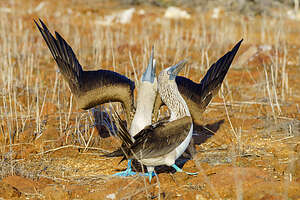 Continuing with the courtship ritualNorth Seymour Island is home to the largest colony of Magnificent Frigatebirds in the entire Galapagos.
Continuing with the courtship ritualNorth Seymour Island is home to the largest colony of Magnificent Frigatebirds in the entire Galapagos.
We were fortunate to be here in March during their breeding season, when they perform their famous courtship ritual, during which the males inflate their red chest globes in order to attract the females. It’s crazy! It looks like a huge red balloon is attached to their chest. The females are attracted to those males that have the the brightest and most long-lasting throat pouch.
Frigatebirds mate just once a year and lay only one egg that takes 50 days to hatch. The chicks then spend a whole year with the parents, a particularly long period of time for a seabird.
.thumbnail.jpg) Making his not too subtle moveWhile other Galapagos birds dive for their lunch, Frigatebirds can’t get wet, because their preen gland doesn’t produce enough oil to waterproof their wings. So, they have to be pirates, surviving by stealing food from other diving birds, especially the blue-footed boobies whom they harass in mid-air until they drop their food, sometimes because they are so stressed that they vomit. The frigatebird then swoops down and plucks the dropped food out of the air.
Making his not too subtle moveWhile other Galapagos birds dive for their lunch, Frigatebirds can’t get wet, because their preen gland doesn’t produce enough oil to waterproof their wings. So, they have to be pirates, surviving by stealing food from other diving birds, especially the blue-footed boobies whom they harass in mid-air until they drop their food, sometimes because they are so stressed that they vomit. The frigatebird then swoops down and plucks the dropped food out of the air.
Their wings are massive and they have a deeply forked tail, allowing for speed and graceful aerial acrobatics, an adaptation that allows them to be very successful pirates. Plus, not having enough oil to secret on their wings has also provided them with the advantage of being lighter and more maneuverable, another useful trait for an air pirate.
Evolution is so neat!
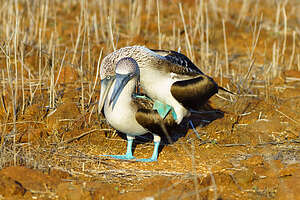 Bingo!While the word Galapagos means Tortoise, the most famous and popular of the creatures to see on the Galapagos Islands are the adorable Blue-Footed Boobies, given their name “bobos” (clowns) by Spanish sailors because of their unusually colored feet and their silly behavior. Their distinctly bright blue color of their feet comes from carotenoid pigments obtained from their fresh fish diet.
Bingo!While the word Galapagos means Tortoise, the most famous and popular of the creatures to see on the Galapagos Islands are the adorable Blue-Footed Boobies, given their name “bobos” (clowns) by Spanish sailors because of their unusually colored feet and their silly behavior. Their distinctly bright blue color of their feet comes from carotenoid pigments obtained from their fresh fish diet.
Continuing along the inland trail, we came upon a major blue-footed booby nesting area.
The blue-footed boobies were very fun to watch, especially during their mating season when they perform their famous courtship dance. During my pre-trip research I had been disappointed to learn that this takes from June to August, but they must not have gotten the memo because here they were in full swing on North Seymour Island in March.
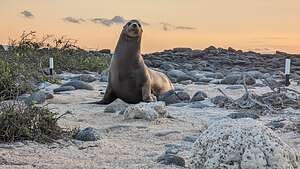 Galapagos Sea LionTheir elaborate courtship ritual begins with the male presenting the female with a small stick or stone. He then tips his beak up to the sky with wings behind his back, while he marches around the female lifting his feet (which he is obviously very proud of) in a high-stepping strut, pointed at a 45 degree angle. The bluer the feet, the more attractive he is to the female. The female’s feet are even bluer than his.
Galapagos Sea LionTheir elaborate courtship ritual begins with the male presenting the female with a small stick or stone. He then tips his beak up to the sky with wings behind his back, while he marches around the female lifting his feet (which he is obviously very proud of) in a high-stepping strut, pointed at a 45 degree angle. The bluer the feet, the more attractive he is to the female. The female’s feet are even bluer than his.
We were fortunate to actually be able to take photos and videos pretty close up of them doing this. I was in charge of video, but just when things were getting hot, I fumbled with my phone and missed taking the video of the actual copulation. I can be excused, however, because it literally only took 10 seconds. I think Herb did get some photos though.
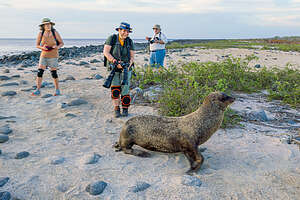 Making friends with a friendly fur sealI did manage to capture some drama afterwards though, when another blue-footed boobie flew in and a fight broke out. Not sure if the extra boobie was a male or a female, but they definitely felt put out by something.
Making friends with a friendly fur sealI did manage to capture some drama afterwards though, when another blue-footed boobie flew in and a fight broke out. Not sure if the extra boobie was a male or a female, but they definitely felt put out by something.
The female will lay two to three eggs, and both parents will take turns using their large feet to incubate them while the other watches for predators, such as the Galapagos Hawk. The egg takes about 45 days to hatch and then they are fed regurgitated fish by both parents. They stay with their parents about 2 months before setting out on their own.
We would see blue-footed boobies incubating their eggs later on this trip when we got to Española Island.
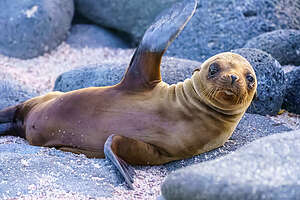 Fur Seals bidding us farewellWe met some Galapagos Sea Lions and Fur Seals on the beach back where the panga would pick us up.
Fur Seals bidding us farewellWe met some Galapagos Sea Lions and Fur Seals on the beach back where the panga would pick us up.
Although land iguanas, frigatebirds, and blue-footed boobies were animals the likes of which we had never seen before, sea lions were something we were very familiar with in California, except these were a bit smaller. In fact, the ones on the Galapagos were originally considered a subspecies of the California ones, but have now attained full species recognition.
Galapagos Sea Lions are extremely friendly and playful and we would spend much time snorkeling with them later on the trip. The bulls, however, can be quite aggressive, constantly defending his shoreline territory and harem of females. We would have a few close encounters with them later in the trip.
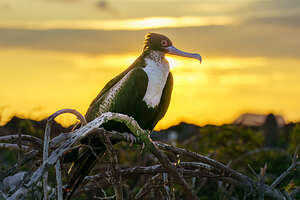 Giant FrigatebirdGalapagos Fur Seals, with their double coat of insulation, seems a bit out of place on the equator. They kind of found their way here north along the Humboldt Current during the Ice Age and became isolated here after the waters warmed and the glaciers melted, eventually becoming an endemic species.
Giant FrigatebirdGalapagos Fur Seals, with their double coat of insulation, seems a bit out of place on the equator. They kind of found their way here north along the Humboldt Current during the Ice Age and became isolated here after the waters warmed and the glaciers melted, eventually becoming an endemic species.
They have some challenges. Firstly, to cope with the heat when they are on land they need to seek out shady shelter in the grottos along rocky shores. Secondly, sharks find them quite tasty, so they fish at night to avoid them and to take advantage of the greater number of fish near the surface at night.
A particularly friendly one waved goodbye to us as we got back on our panga.
Wow! We had seen land iguanas, magnificent frigatebirds inflating a red balloon on their chest, great frigatebirds, blue-footed boobies mating, Galapagos sea lions, and Galapagos fur seals. The trip could be over now and I would be satisfied.
Then it was back on board our ship, a delicious dinner, and our nightly briefing as to what to expect tomorrow. We were exhausted and still not fully unpacked.
Recap of creatures we saw today: land iguanas, magnificent frigatebirds inflating a red balloon on their chest, great frigatebirds, blue-footed boobies mating, Galapagos sea lions, and Galapagos fur seals.
Andean Cloud Forest
Wednesday, March 15, 2023 - 2:30pm by Lolo0 miles and 0 hours from our last stop - 1 night stay
Travelogue
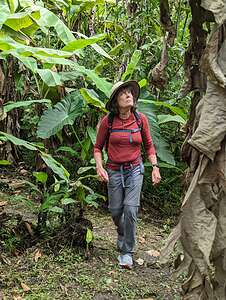 Lolo of the Cloud ForestBesides the 11-day cruise in the Galapagos, Galapagos Travels offers several excursions from Quito, such as trips to the Amazon, Volcanoes, the Bellavista Cloud Forest, etc.
Lolo of the Cloud ForestBesides the 11-day cruise in the Galapagos, Galapagos Travels offers several excursions from Quito, such as trips to the Amazon, Volcanoes, the Bellavista Cloud Forest, etc.
We chose to take the 2-day excursion to the Bellavista Cloud Forest, located near the top of the famed Tandayapa Valley, within the Andean cloud forest region, a type of mid-altitude tropical rainforest that extends from 3,000 to 8,000 feet elevation. The Bellavista Reserve stands at 7,300 feet.
Cloud forests are like rain forests in that they both receive high levels of precipitation. However, the cloud forests get much of their precipitation directly from the clouds that filter through the trees.
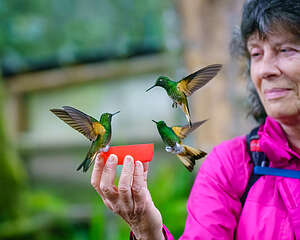 The hummingbird whispererThese consistent clouds are the result of transpiration of humid air from the billions of trees in the lowland Amazon moving up the mountain slopes of the Andes, condensing and falling as rain or remaining in the form of low clouds and mist. The atmospherics are truly magical.
The hummingbird whispererThese consistent clouds are the result of transpiration of humid air from the billions of trees in the lowland Amazon moving up the mountain slopes of the Andes, condensing and falling as rain or remaining in the form of low clouds and mist. The atmospherics are truly magical.
Although cloud forests account for only 1% of global woodland, they have an incredible amount of biodiversity. The Ecuadorian cloud forests are considered the single richest hotspot on the planet, containing 17% of the world’s plant species, including thousands of species of orchids and nearly 20% of its bird diversity.
In order to take full advantage of our day (and especially early morning when the wildlife is more active), our guide picked us up at the hotel at 6:00 a.m. and we drove with three other of our tour group colleagues (Tom, Steve, and Bircan) on the winding roads to Bellavista Lodge (90 minutes west of Quito) where we would be spending the night. The final 12 kilometers of the drive was along a very bumpy dirt road.
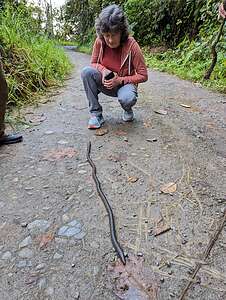 Giant EarthwormOur driver stopped and let us out when we came upon a giant 4-foot earthworm crossing the road, making me wonder if the earthworms were this big, what was the rest of the fauna going to be like.
Giant EarthwormOur driver stopped and let us out when we came upon a giant 4-foot earthworm crossing the road, making me wonder if the earthworms were this big, what was the rest of the fauna going to be like.
We continued on to the Bellavista Cloud Forest Lodge, our home for the night, where we were greeted by Alfredo, our naturalist guide. After quickly dropping off our luggage in our cabin, which was lovely with a separate sitting room with big windows looking out over the forest, we met for breakfast in the Lodge restaurant - our second breakfast of the day.
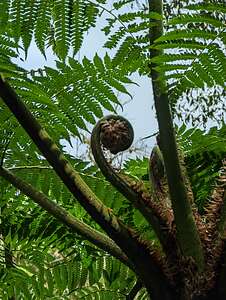 Tree FernNo time was wasted, and once breakfast was complete, we met by the hummingbird feeders and then set out with Alfredo to walk the trails of the Bellavista Reserve.
Tree FernNo time was wasted, and once breakfast was complete, we met by the hummingbird feeders and then set out with Alfredo to walk the trails of the Bellavista Reserve.
Armed with just my Google Pixel 7 Pro cellphone as my camera, I admit to having a bit of lens envy as I looked at the rest of the group’s camera equipment. Closeups of faraway or flying birds were definitely not going to be my forte on this stroll, so I decided to focus (no pun intended) on hummingbirds and the interesting flora. I would leave the toucans to Herb.
Cloud forests are the perfect habitat for epiphytes (sometimes known as air plants), which are plants that grow on other plants. The trees in the forest are festooned with bromeliads, orchids, mosses, and more.
There were also very interesting little insects and even a tiny frog that was smaller than half an ¼ inch. Not having the long telephoto lenses that my colleagues had, I tried to get up a little too close and personal to him, which caused him to disappear into thin air. Fortunately, Herb got to him before I did.
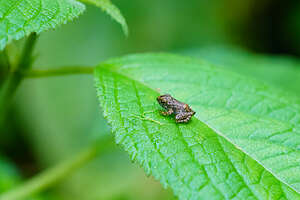 Itsy bitsy frogSince I was having trouble photographing distant birds with my cell phone, I decided to deal with the flora because it stood still. One of my favorites was the Tree Ferns, where their curly fiddleheads (named for obvious reasons). The fiddleheads of a young fern are harvested for a vegetable. Everything in the Andean cloud forest seems to have a use.
Itsy bitsy frogSince I was having trouble photographing distant birds with my cell phone, I decided to deal with the flora because it stood still. One of my favorites was the Tree Ferns, where their curly fiddleheads (named for obvious reasons). The fiddleheads of a young fern are harvested for a vegetable. Everything in the Andean cloud forest seems to have a use.
At one point during our hike, Alfredo stopped us along the trail to allow Steve to make an announcement as to another choice in our itinerary. He asked if we would all be willing to pay an extra $39 pp (which later turned out to be $55 pp) to take an early excursion the next morning to see the “Cock of the Rock.” Never too old for low-form humor, his announcement was greeted with immature giggling from the rest of us. It got worse when Steve described the bird as being larger than 6 inches with a funny-looking head, which brought us to our knees. Knowing him better later, I realized he knew exactly how to get a reaction from the crowd. I love British humor.
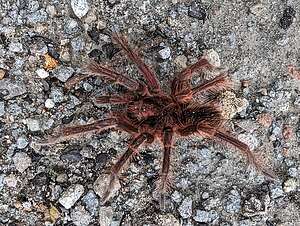 Oh my!We all agreed that we absolutely must see the “Cock.”
Oh my!We all agreed that we absolutely must see the “Cock.”
When we got back near the lodge, we were greeted in the parking lot by a big hairy tarantula. I had never seen one up close and personal before, so it was a little bit exciting. I just hoped he wouldn't find his way to our room.
After our walk, we spent some time at the hummingbird feeders where there are 15 different species zipping and buzzing around, often landing on us. Their tiny little feet gripping my finger felt really weird and I had to stop myself from shaking it off.
Alfredo tried to set up a more natural setting than a feeder for them to land on by pouring sugar water over a stalk with flowers, but they weren’t buying it. Instead they landed on his shoulder and watched his efforts.
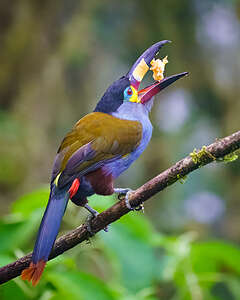 Plate-billed mountain toucanThere was also a beautiful toucan nearby enjoying a piece of a banana, pieces of which are left around the lodge to attract birds. Based on its coloring I think it was a plate-billed mountain toucan, which is only found in the Andean cloud forest in northwestern Ecuador.
Plate-billed mountain toucanThere was also a beautiful toucan nearby enjoying a piece of a banana, pieces of which are left around the lodge to attract birds. Based on its coloring I think it was a plate-billed mountain toucan, which is only found in the Andean cloud forest in northwestern Ecuador.
It was starting to rain a bit, as it does almost every day after 2 p.m., so we returned to our lovely cabin and had a very cozy siesta on the daybed in our sitting room before having to join the rest of the group for dinner at the Lodge.
After dinner, we were supposed to take a night walk to see a bird that returns to sit on its egg at night, but it was raining pretty hard. No one wanted to be the first to say they didn’t want to go, but once one of us did, everyone else quickly followed suit. Besides, we had a very early morning ahead of us to drive to a place to see the “Cock of the Rock.”
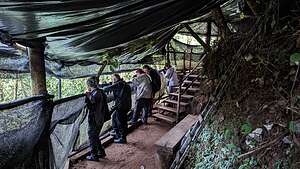 Cock of the Rock blindThe next morning,we left before sunrise (and breakfast) to drive the 50 minutes to the Reserva la Victoriana, a private reserve where there is a lek (communal gathering spot for male “Cock of the Rock” birds). There are only a few leks scattered throughout the Andean Cloud Forest.
Cock of the Rock blindThe next morning,we left before sunrise (and breakfast) to drive the 50 minutes to the Reserva la Victoriana, a private reserve where there is a lek (communal gathering spot for male “Cock of the Rock” birds). There are only a few leks scattered throughout the Andean Cloud Forest.
As the sun rose, we marched through a very different topography than at Bellavista - much more expansive views and different vegetation. In a little less than a half mile we arrived at a blind and immediately began hearing the screeching sound of the male Cock of the Rock, coming from the ravine below us. Their call has sometimes been compared to the sound a screaming robot might make.
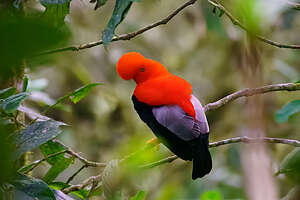 Cock of the RockAs with most birds, male is much more attractive with a brilliant red-orange plumage, black and white wings, purple on his back, and a large fan-like crest that almost completely obscures his bill. Known as tunki in Quechua, he is the national bird of Peru. In comparison, the more drab female is darker and browner.
Cock of the RockAs with most birds, male is much more attractive with a brilliant red-orange plumage, black and white wings, purple on his back, and a large fan-like crest that almost completely obscures his bill. Known as tunki in Quechua, he is the national bird of Peru. In comparison, the more drab female is darker and browner.
Males gather at communal gathering spots called leks, which are usually down in a ravine near a stream. It is at these leks that they compete for breeding females with each male displaying his colorful plumage, bobbing and hopping, and making a variety of bizarre squeaking and grunting sounds.
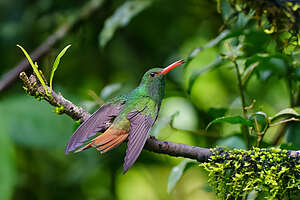 Hummingbird at the Alambi PreserveAfter mating, the female makes a nest under a rocky overhang, incubates the eggs, and rears the young by herself. Hence, the “Rock” part of this bird’s name.
Hummingbird at the Alambi PreserveAfter mating, the female makes a nest under a rocky overhang, incubates the eggs, and rears the young by herself. Hence, the “Rock” part of this bird’s name.
The birds were too far away and too fast for me to capture a good image with my cell phone, but I did enjoy passing the hour watching their antics (both the birds and the photographers). Thankfully, after probably hundreds of attempts, Herb was able to capture some great images.
After breakfast, we continued on to the Alambi Preserve, a family project for the conservation of the cloud forest in the famous Tandayapa Valley. It was a very different experience than our early morning trek to get to the Cock of the Rock lek to hear and watch them do their mating display.
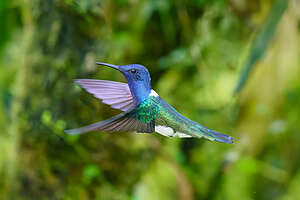 Hummingbird at the Alambi PreserveMuch less wild, the Alambi Preserve had beautifully gardens with beautiful endemic varieties and a hummingbird garden, where one could sit in a chair and watch 30 different species of hummingbirds visit the 8 hummingbird feeders.
Hummingbird at the Alambi PreserveMuch less wild, the Alambi Preserve had beautifully gardens with beautiful endemic varieties and a hummingbird garden, where one could sit in a chair and watch 30 different species of hummingbirds visit the 8 hummingbird feeders.
They were fascinating to watch and I discovered the joy of slow motion video and the interesting effect of slowing down their frantic wing beating from 70 flaps per second to more like 5 times. That entertained me for almost an hour.
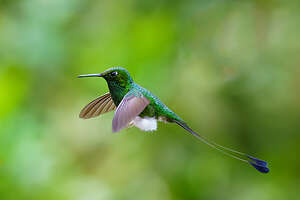 Booted Rackettail hummingbirdHerb got some beautiful photos of hummingbirds in flight. My absolute favorite was of the one with the strange tail feathers that looked like little flippers or boots. I later was able to identify it as a Booted Rackettail, because of what looked like little boots at the end of his tail.
Booted Rackettail hummingbirdHerb got some beautiful photos of hummingbirds in flight. My absolute favorite was of the one with the strange tail feathers that looked like little flippers or boots. I later was able to identify it as a Booted Rackettail, because of what looked like little boots at the end of his tail.
I eventually pulled myself away from the hummingbirds, and wandered through a lovely garden with many varieties of beautiful endemic plants. Everyone was still behind at the hummingbird feeders, so I had the garden to myself.
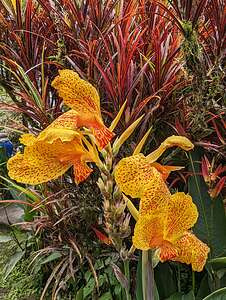 Canna Yellow King HumbertI am no botanist, but you didn’t have to be one to appreciate these beautiful and unique plants. I had no idea what I was seeing at the time, but since coming home I have used Google Lens to identify them.
Canna Yellow King HumbertI am no botanist, but you didn’t have to be one to appreciate these beautiful and unique plants. I had no idea what I was seeing at the time, but since coming home I have used Google Lens to identify them.
Canna “Yellow King Humbert” - rich deep yellow flowers, copiously splashed with fiery orange. The brilliant blossoms contrast nicely with a lush foliage of large, lamp shaped, apple green leaves. The contrast between its bright yellows and oranges was accentuated by the lovely tall red blades growing behind it.
Right nearby was a Heliconia Psittacorum - Erect, evergreen perennial with dense tufts of bright green leaves with pointy tips. The clusters of flowers are quite distinctive and range in colorful use of red, orange, yellow and green. The flowers produce and abundance of nectar and the color.
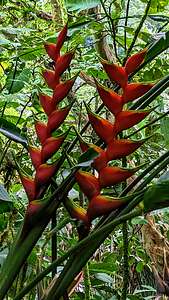 Heliconia CaribaeaEven the vines were works of art. Sanchezia Speciosa - an evergreen shrub that grows in the shady understory of tropical forests. The large variegated leaves have defined yellow veins and grow in an alternating pattern on the stems.
Heliconia CaribaeaEven the vines were works of art. Sanchezia Speciosa - an evergreen shrub that grows in the shady understory of tropical forests. The large variegated leaves have defined yellow veins and grow in an alternating pattern on the stems.
Next, near the hydrangea, I came across what looked like a bowl of rich, dark green leaves filled with hundreds of light green peas, which I later learned were hydrangea buds.
My all time favorite, however, was the Heliconia Caribaea, a large evergreen perennial with huge, oblong, leathery, dark green leaves and spectacular red flowers (6 to 8 inch long), which are actually modified leaves in the shape of lobster claws. I had never seen anything like them.
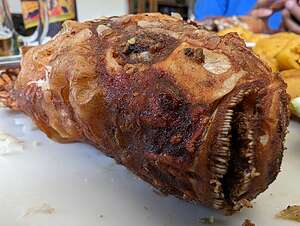 Tilapia as the locals like itWe ended our Cloud Forest excursion with a nice lunch at the Alambi Preserve restaurant. The waitress was a bit difficult to understand, so when Tom, one of our Galapagos Travel colleagues, who is admittedly not a very adventurous eater, asked if the tilapia was breaded, she answered “bones.” Tom was silent for a brief moment, obviously confused as to her reply, but eventually said “okay.”
Tilapia as the locals like itWe ended our Cloud Forest excursion with a nice lunch at the Alambi Preserve restaurant. The waitress was a bit difficult to understand, so when Tom, one of our Galapagos Travel colleagues, who is admittedly not a very adventurous eater, asked if the tilapia was breaded, she answered “bones.” Tom was silent for a brief moment, obviously confused as to her reply, but eventually said “okay.”
One of the biggest laughs I had the entire trip, was watching Tom’s face when this was placed before him. I can still crack up just remembering the expression on his face.
Then it was back to the Mercure Alameda Hotel. Tomorrow was the big day - our flight from Quito to the Galapagos. Since there are a lot of additional security checks and procedures to go through when going to the Galapagos, it was going to be another early to bed night with a very early morning departure. All we had time for was dinner at the hotel’s Spicy Bistro restaurant, which was very good.
Quito
Monday, March 13, 2023 - 2:30pm by Lolo0 miles and 0 hours from our last stop - 2 night stay
Travelogue
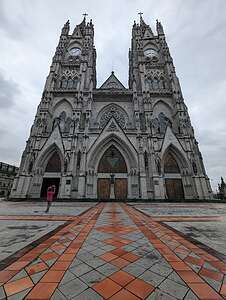 Basílica del Voto NacionalOur base camp in Quito was the lovely Mercure Alameda Hotel, located in walking distance to the historic Old Town.
Basílica del Voto NacionalOur base camp in Quito was the lovely Mercure Alameda Hotel, located in walking distance to the historic Old Town.
Although we arrived around midnight, Quito is only two hours later than San Francisco, so it felt more like 10:00 p.m., and there really was no jet lag to deal with, making for an easy transition.
Since we only had one full-day to explore Quito, we immediately went to sleep and surprisingly (for me at least) woke up at 7:30 a.m. feeling quite refreshed and ready to get going. The hotel had a delicious free buffet, which would keep us satiated for quite a few hours.
We had watched numerous YouTube videos on top things to do in Quito, so we had carefully chosen how to best utilize our short time here. Also, the guide books warned of safety issues, such as making sure you only used an Uber or an authorized (legal) taxi, as there have been issues of “express kidnapping,” where the driver takes passengers at gunpoint to an ATM, withdraws their money, and then lets them go. That was not high on our list of things to do in Quito, although it would have provided an interesting story for Lolo’s Extreme. Other warnings were about sketchy neighborhoods to avoid.
 Basílica del Voto NacionalWe decided to limit ourselves to the Old Town historic district, a UNESCO World Heritage Site known for its narrow streets, Spanish colonial architecture, and historic attractions.
Basílica del Voto NacionalWe decided to limit ourselves to the Old Town historic district, a UNESCO World Heritage Site known for its narrow streets, Spanish colonial architecture, and historic attractions.
The Basilica del Voto Nacional was the top thing we wanted to see in Quito, both because of its beauty and significance, as well as for the opportunity to climb the steep rickety steps and ladders to the top of its towers for a stunning view of Quito below.
It is the largest neo-Gothic church in all of South America. Like every large cathedral we have ever visited, it was undergoing some construction, which in this case was a good thing, because according to local legend, the world will end if construction of the basilica is ever officially completed. I would hate to have that happen before we finally got to the Galapagos. We were thwarted once because of Covid, so the world ending on our second attempt would really be a bummer.
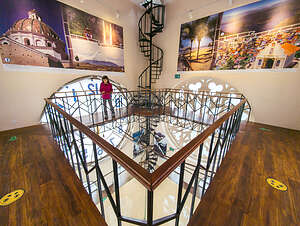 Climbing to the top of the Basilica TowerThe cathedral was designed in 1890 by the French architect Emilio Tarlier, who was inspired by the Notre Dame and Bourges cathedrals. It took over 30 years to build the basilica. The first mass and ringing of the bells took place in 1924. Pope John Paul II blessed the church in 1985, and it was consecrated and finally inaugurated in 1988.
Climbing to the top of the Basilica TowerThe cathedral was designed in 1890 by the French architect Emilio Tarlier, who was inspired by the Notre Dame and Bourges cathedrals. It took over 30 years to build the basilica. The first mass and ringing of the bells took place in 1924. Pope John Paul II blessed the church in 1985, and it was consecrated and finally inaugurated in 1988.
It is an extremely impressive structure - 460 feet long and 115 feet wide, with its two frontal towers reaching a height of 377 feet. I particularly enjoyed the gargoyles protruding from the exterior: Ecuadorian iguanas, tortoises, armadillos, and Andean condors, chosen to represent the local endemic fauna rather than classic mythological or religious figures.
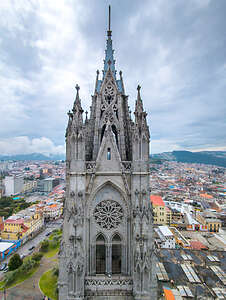 View of one Basilica Tower from the otherAfter admiring the exterior, we went around the back of the church and paid our $3 to begin our ascent to the top of the tower, which is 16 stories high. You can either take an elevator to the top or walk it. We chose to walk it. The YouTube video we had watched of a couple climbing it made it seem much scarier and strenuous than it actually was, although the fact that Quito is 9,000 feet above sea level did make our breathing a little harder.
View of one Basilica Tower from the otherAfter admiring the exterior, we went around the back of the church and paid our $3 to begin our ascent to the top of the tower, which is 16 stories high. You can either take an elevator to the top or walk it. We chose to walk it. The YouTube video we had watched of a couple climbing it made it seem much scarier and strenuous than it actually was, although the fact that Quito is 9,000 feet above sea level did make our breathing a little harder.
We began ascending a few narrow, winding stairs which eventually brought us to a level from which we could look down onto the interior of the cathedral with its long central nave and stunning stained glass windows. Although we couldn’t see them from this vantage point, there are 24 small chapels surrounding the central nave, each dedicated to an Ecuadorian province.
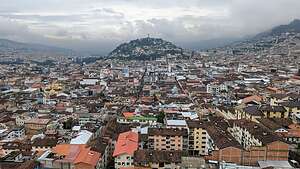 View from atop the Basilica TowerFrom there we continued climbing up above the ceiling of the Basilica where there is a wooden walkway above the church roof connecting to the other tower, but it was blocked off at the end because of construction - or fake construction so the world wouldn’t end.
View from atop the Basilica TowerFrom there we continued climbing up above the ceiling of the Basilica where there is a wooden walkway above the church roof connecting to the other tower, but it was blocked off at the end because of construction - or fake construction so the world wouldn’t end.
Along the way, there were windows in the tower walls where we got views of the other tower as well as close ups of the interesting gargoyles.
On the 10th floor there was a cafe serving snacks and beer. Beer in a cathedral was a novel idea, which we passed up because it was only 10 a.m.
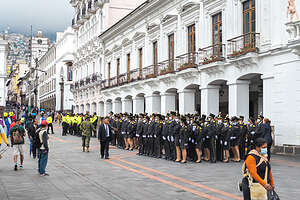 Carondelet Palace in the Plaza GrandeEventually we came to the floor where we stood behind the huge clocks on the four sides of the tower. It was an interesting perspective to see the clocks in reverse.
Carondelet Palace in the Plaza GrandeEventually we came to the floor where we stood behind the huge clocks on the four sides of the tower. It was an interesting perspective to see the clocks in reverse.
The final ladders to the top were actually outside the tower with metal rungs that we could look through down to the ground hundreds of feet below, which did freak out the YouTube couple, but I am always okay as long as I have a railing to hold onto.
Once at the top, we had a fabulous 360 degree view of Quito with El Panecillo looming in the background topped with a huge 45-meter high statue of the Virgin Mary with wings, which can be seen from practically anywhere you are in the city. El Panecillo translates to “The Little Bread Loaf,” and it’s easy to see why.
 Metropolitan Cathedral in the Plaza GrandeThe irony to me was that El Panecillo is one of the sketchiest places in the city despite the Virgin Mary’s presence. All the guidebooks warn you to take a taxi to visit the statue because it is not safe to walk there.
Metropolitan Cathedral in the Plaza GrandeThe irony to me was that El Panecillo is one of the sketchiest places in the city despite the Virgin Mary’s presence. All the guidebooks warn you to take a taxi to visit the statue because it is not safe to walk there.
Once we were ready to come down, we had to go backwards down the metal rung ladder for a bit, which can be pretty unnerving for some.
We continued down from whence we came, sadly still too early for a cerveza in the cafe. Perhaps later, at a more respectable time, after we visited some other sights in the Old Town.
 Exterior of Iglesia de la Compania de JesusFrom there, we headed to the heart of Quito’s Old Town, the Plaza Grande, also known as Independence Square, where palm trees and well-manicured gardens line the walkways through the park, with a large fountain in the center.
Exterior of Iglesia de la Compania de JesusFrom there, we headed to the heart of Quito’s Old Town, the Plaza Grande, also known as Independence Square, where palm trees and well-manicured gardens line the walkways through the park, with a large fountain in the center.
The plaza is surrounded by ornate colonial architecture, the most impressive of which is the Carondelet Palace, where Ecuador’s president lives and works. In front of the palace a group of Ecuadorian military (both male and female) were assembled for inspection. That plus the presence of at least two dozen police officers made this the safest place to be in Quito.
Near to the Palace is the Metropolitan Cathedral, a Catholic church also known as the Cathedral of Quito. Construction began in 1565, with various additions and renovations made until it was completed in 1806. Rather eclectic, it has a variety of architectural styles that blend very well together - Gothic style arches, a Baroque main altar, a Neoclassical choir area, and Moorish style ceilings.
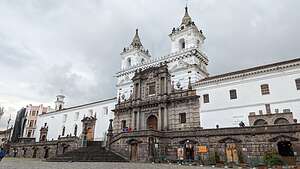 Plaza de San FranciscoThe murals inside blend European Christian iconography with a unique Andean interpretation. An imitation of the Last Supper has the disciples dining on guinea pig (an Ecuadorian favorite) and a nativity scene has llamas along with the usual farm animals.
Plaza de San FranciscoThe murals inside blend European Christian iconography with a unique Andean interpretation. An imitation of the Last Supper has the disciples dining on guinea pig (an Ecuadorian favorite) and a nativity scene has llamas along with the usual farm animals.
A stone’s throw away from the Plaza Grande is another large cathedral, the Iglesia de la Compania de Jesus (Church of the Jesuits), the most ornate and beautiful of all. I know Ecuador is a very Catholic country, but there are four huge cathedrals in a little more than a square mile. I wonder how filled they are on Sundays.
 Religious art in Museo Fray Pedro GocialBuilt by Jesuits between 1605 and 1765, this church is the pinnacle of Latin American Baroque. The church is known for its gold plated interior built by artists from the Quito School, who skillfully carved and gilded every inch of the Church with 23-carat gold sheets. My biggest regret is that photography was not allowed, meaning I am going to basically forget that I have ever been here.
Religious art in Museo Fray Pedro GocialBuilt by Jesuits between 1605 and 1765, this church is the pinnacle of Latin American Baroque. The church is known for its gold plated interior built by artists from the Quito School, who skillfully carved and gilded every inch of the Church with 23-carat gold sheets. My biggest regret is that photography was not allowed, meaning I am going to basically forget that I have ever been here.
However, the exterior was not off limits, so we were able to photograph the lovely green and gold domes atop the church.
We continued a short distance (4 minute walk) to the Plaza de San Franisco, one of Quito’s most beautiful squares, surrounded by whitewashed walls and the twin bell towers of Ecuador’s oldest church and the Andes mountains in the background. It was our fourth and final church of the day.
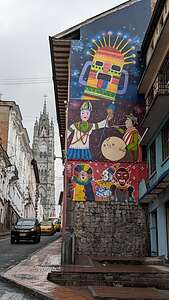 Street art in Old Town QuitoThe plaza is dominated by the Iglesia and Convento de San Francisco - the largest religious complex in South America. Established in 1536 by Franciscan monks, this magnificent architectural masterpiece features a museum (Museo Fray Pedro Gocial) in its convent with one of the most beautiful and complete collections of Quito Art from the 16th, 17th and 18th centuries.
Street art in Old Town QuitoThe plaza is dominated by the Iglesia and Convento de San Francisco - the largest religious complex in South America. Established in 1536 by Franciscan monks, this magnificent architectural masterpiece features a museum (Museo Fray Pedro Gocial) in its convent with one of the most beautiful and complete collections of Quito Art from the 16th, 17th and 18th centuries.
As with the inclusion of local fauna on gargoyles of the Basilica del Voto Nacional, many design motifs from indigenous cultures were to be found within the complex, such as faces of sun gods and harvest symbols of flowers and fruit.
There were also plenty of morbid and ghoulish sculptural works, with plenty of skulls and other metaphors for death in order to inflict the proper level of fear of consequences for a sinful life.
 Herb on the streets of the Old TownOn a more pleasant note, we stumbled into a room with beer making equipment and a large table with benches on either side. So maybe the monks were not all gloom and doom. I liked to imagine them gathering around this table together just to chill and enjoy a good beer together.
Herb on the streets of the Old TownOn a more pleasant note, we stumbled into a room with beer making equipment and a large table with benches on either side. So maybe the monks were not all gloom and doom. I liked to imagine them gathering around this table together just to chill and enjoy a good beer together.
Speaking of, it was getting near beer o’clock for us, so time to move on.
We left the Old Town and headed towards the Calle La Ronda, described in the books as a narrow cobblestone lane lined with postcard-perfect 17th century buildings, festive restaurants, bars, art galleries, and elegant shops. I pictured it being like Las Ramblas in Barcelona
I navigated to a random spot on Calle La Ronda and we started walking there. I’m not sure if we were on the wrong section of the street or whether we were just tired, but we started to feel a bit unsafe and uncomfortable. Unsavory characters were getting a little too close and the neighborhood definitely looked a bit sketchy. The angel atop El Panecillo was looming over us, which wasn’t a good thing, because that was the area we were warned to avoid.
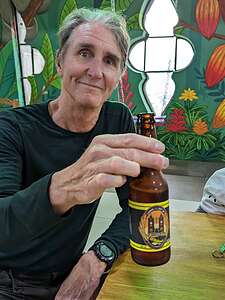 Herb enjoying his first beer in a basilicaI did read in the guidebooks that La Calle Ronda looks more “romantic” at night, but we weren’t anxious to find out.
Herb enjoying his first beer in a basilicaI did read in the guidebooks that La Calle Ronda looks more “romantic” at night, but we weren’t anxious to find out.
We pointed ourselves back to the Basilica del Voto Nacional with the hope of having our first beer in a church. The guy at the entrance recognized us and let us back in for free. I don’t think he’d ever seen anyone that wanted to climb the tower twice in one day. Beer is a great motivator.
Unsure what floor the cafe was on, we forged on. I told Herb I was pretty sure it was on the 6th, but it turned out to be all the way up to the 10th (oops!).
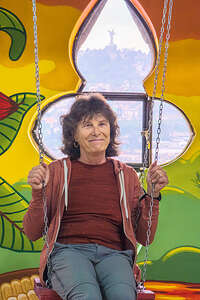 Lolo enjoying the swing in the Basilica cafeThe lunch menu consisted of only one item: a jamón, tomato, lettuce and cheese sandwich. I thought she said “jam”, tomato, and cheese, and thought “that’s weird,” but I figured I would go with the local cuisine. Besides, there was no other choice. Oh, and, of course, a round of the nice cold cervezas.
Lolo enjoying the swing in the Basilica cafeThe lunch menu consisted of only one item: a jamón, tomato, lettuce and cheese sandwich. I thought she said “jam”, tomato, and cheese, and thought “that’s weird,” but I figured I would go with the local cuisine. Besides, there was no other choice. Oh, and, of course, a round of the nice cold cervezas.
The atmosphere was simple but cute, and we were the only ones in there. There was even a swing with a view through a window behind it of the Virgin Mary atop El Panecillo. She really was everywhere, like those crazy eyes that follow you on some portraits.
By the time we climbed the 10 flights down, it was pouring rain out, so we called an Uber which brought us back to the Mercure Alameda for $2.50.
We were pretty beat and we had to get up at 5:00 the next morning to go on the tour to the Cloud Forest, so we just showered, took a quick nap, and went downstairs to eat dinner in the hotel restaurant, the Spicy Bistro, which turned out to be very good.
Athens
Tuesday, October 18, 2022 - 5:30pm by Lolo245 miles and 9.5 hours from our last stop - 1 night stay
Travelogue
.thumbnail.jpg) The National Archaeology Museum of AthensOur 9/12-hour ferry from Crete delivered us to Athens, well rested and in time for breakfast back at the Acropolis Select, the hotel we had stayed in when this adventure started.
The National Archaeology Museum of AthensOur 9/12-hour ferry from Crete delivered us to Athens, well rested and in time for breakfast back at the Acropolis Select, the hotel we had stayed in when this adventure started.
Tassos did not let any moss grow under our feet. Right after breakfast we boarded our bus, which took us to the National Archaeological Museum, which holds the world’s best collection of ancient Greek Art. Now that we had been in Greece for two weeks and seen so much, it would be a nice wrapup to our tour.
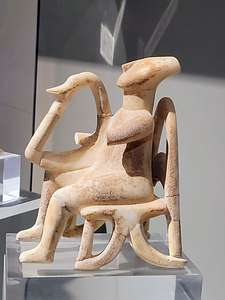 Cycladic Male-Seated Harp PlayerI love Art History and often spend my spare time reading Art History textbooks, so I was very excited to see some familiar favorites.
Cycladic Male-Seated Harp PlayerI love Art History and often spend my spare time reading Art History textbooks, so I was very excited to see some familiar favorites.
The museum traces the history of Greece’s various civilizations: the Minoans, the Mycenaeans, Archaic Greece, the Classical Age, Alexander the Great, and the Romans. That’s a lot of millennia to cover.
The exhibits are displayed chronologically so we started our journey in the early Bronze Age with a terracotta figurine called "The Thinker", estimated to have been made around 4000 BCE. While its purpose is unknown, it is thought to have been some sort of fertility figure. I thought he was adorable.
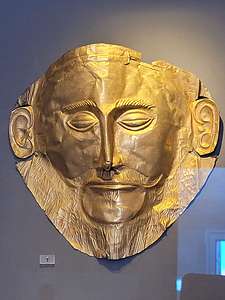 Death Mask of AgamemnonNext up was the Cycladic collection, featuring the famous marble figurines from the Aegean islands of Delos and Keros. These mysterious human representations, which resemble modern art, came from the 3rd millennium BCE old cemeteries throughout the Aegean islands, along with bronze tools and containers. This more intricate example is called the Male-Seated Harp Player. It was found on the island of Keros and dates from the Early Cycladic period (2800 - 2300 BCE). Amazing to think this finely detailed figure was sculpted around 5,000 years ago. Need I say, he was adorable too.
Death Mask of AgamemnonNext up was the Cycladic collection, featuring the famous marble figurines from the Aegean islands of Delos and Keros. These mysterious human representations, which resemble modern art, came from the 3rd millennium BCE old cemeteries throughout the Aegean islands, along with bronze tools and containers. This more intricate example is called the Male-Seated Harp Player. It was found on the island of Keros and dates from the Early Cycladic period (2800 - 2300 BCE). Amazing to think this finely detailed figure was sculpted around 5,000 years ago. Need I say, he was adorable too.
 Archaic period kousosMoving along chronologically, we next came to Room 4, which displays artifacts found in the ruins of the ancient mainland fortress-city of Mycenae, which flourished from 1600 - 1200 BCE. This was the civilization that theoretically battled Troy in Homer’s Iliad.
Archaic period kousosMoving along chronologically, we next came to Room 4, which displays artifacts found in the ruins of the ancient mainland fortress-city of Mycenae, which flourished from 1600 - 1200 BCE. This was the civilization that theoretically battled Troy in Homer’s Iliad.
I immediately recognized what Henry Schliemann named the “Death Mask of Agamemnon.” The mask is made of beaten gold and it was once placed tied over the face of the deceased.
More accurate dating technology, however, showed that it was made several centuries before Agamemnon lived. Oh well.
Some of the earliest surviving examples of the post-Mycenaean, or Archaic Age (700 to 480 BCE), of ancient Greece are life-sized, and some even larger than life-sized, statues of clothed young women (kore/korai) and naked young men (kouros/kouroi).
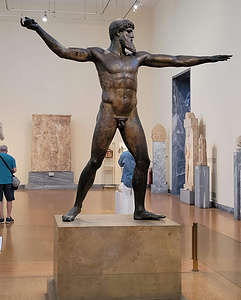 Artemision Bronze (Zeus or Poseidon?)You can see the Egyptian influence in their stiffness, triangular faces, and arms held at their side, except unlike the Egyptian statues, these Archaic Greece statues are actually freestanding and even have some empty space between their legs.
Artemision Bronze (Zeus or Poseidon?)You can see the Egyptian influence in their stiffness, triangular faces, and arms held at their side, except unlike the Egyptian statues, these Archaic Greece statues are actually freestanding and even have some empty space between their legs.
The statues of this period are rather expressionless with the characteristic Archaic smile, a small smile or smirk that was meant to suggest that the subject was alive and in good health. Very little personality comes through during this period.
Continuing on, we came to a room with the Artemision Bronze, discovered amid a 150 BCE shipwreck off Cape Artemision (north of Athens) in 1928. The weapon he once held was never found, so no one knows for sure whether it was Zeus (who would have had a thunderbolt) or Poseidon (who would have had a trident). Or, maybe he was just doing a yoga Warrior 2 pose. It was thought to have been created around 460 BCE.
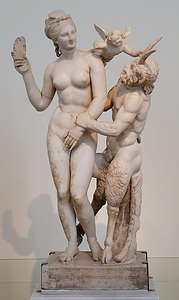 Aphrodite, Pan, and ErosI think the final sculpture I will discuss is one of my favorites: Aphrodite, Pan, and Eros - an example of Hellenistic Greek Art, which was less serious and more erotic than Classical Art. In this statue, dating to about 100 BCE, Aphrodite is playfully fending off Pan’s (half-man, half-goat) lecherous advances with her slipper. Between them, Eros (known as Cupid to the Romans) is obviously up to no good.
Aphrodite, Pan, and ErosI think the final sculpture I will discuss is one of my favorites: Aphrodite, Pan, and Eros - an example of Hellenistic Greek Art, which was less serious and more erotic than Classical Art. In this statue, dating to about 100 BCE, Aphrodite is playfully fending off Pan’s (half-man, half-goat) lecherous advances with her slipper. Between them, Eros (known as Cupid to the Romans) is obviously up to no good.
There was so much more in the museum to talk about, but these were just some of our favorites.
That evening we wrapped up our tour with a farewell dinner at the Cave of the Acropolis, in the Plaka, in the shadows of the sacred rock of the Acropolis.
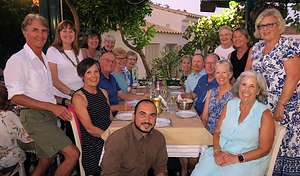
We kind of dreaded the next day - about 24 hours of travel before we would get home. Home is good too though. We were about ready.
Thank you Tassos and the people of Greece for sharing your beautiful land and rich culture with us.
αντίο και ευχαριστώ (Goodbye and thank you)
Crete
Wednesday, September 14, 2022 - 3:15pm by Lolo125 miles and 1.5 hours from our last stop - 3 night stay
Travelogue
Day 1 - Arrival on Crete
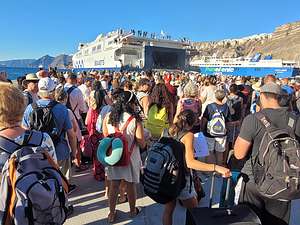 Crete here we comeAfter two wonderful days exploring Santorini, we once again boarded a ferry, this time to Crete, our final island on the tour. We arrived pretty late, around 8:00 pm in the evening, so all there was time for was a quick dinner at the hotel and then bed.
Crete here we comeAfter two wonderful days exploring Santorini, we once again boarded a ferry, this time to Crete, our final island on the tour. We arrived pretty late, around 8:00 pm in the evening, so all there was time for was a quick dinner at the hotel and then bed.
Crete is much bigger than the other islands we had visited, so we would spend 3 days here exploring ancient Minoan ruins, visiting several villages throughout the island, swimming in the Aegean Sea at the famous Matala beach, making pottery, and just immersing ourselves in the culture of Crete (which is quite different from the rest of Greece).
Day 2 - Palace of Knossos, Pottery demonstration, and Heraklion Archaeological Museum
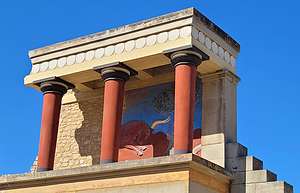 Entrance to the Palace of KnossosBefore arriving, all I knew about Crete was from Art History books - the Palace of Knossos and the myth of the Minotaur, a creature that was half-man and half-bull, and wandered through the labyrinth beneath the palace, munching on youths sent down there as sacrifices.
Entrance to the Palace of KnossosBefore arriving, all I knew about Crete was from Art History books - the Palace of Knossos and the myth of the Minotaur, a creature that was half-man and half-bull, and wandered through the labyrinth beneath the palace, munching on youths sent down there as sacrifices.
Besides being a wonderful tourist destination today, Crete holds the distinction of being the birthplace of Europe’s first advanced civilisation, the Minoan culture, which flourished from 2800 to 1450 BC., and it is the buildings excavated at the Palace of Knossos that are the main source of information about Minoan architecture and culture.
Much of the palace was reconceived and reconstructed by Arthur Evans, who worked here between 1900 and 1932. His reconstruction though is a bit controversial, as archaeologists (including our guide) felt that he took a bit too much creative license in its restoration.
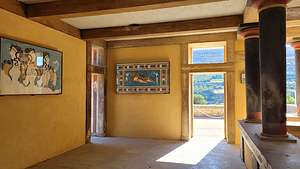 Fresco roomStill, I think it was a lot more interesting to wander through a series of buildings and artifacts that provide a sense of what life was like for the Minoan people more so than if it had just been left in ruins.
Fresco roomStill, I think it was a lot more interesting to wander through a series of buildings and artifacts that provide a sense of what life was like for the Minoan people more so than if it had just been left in ruins.
The Palace was quite advanced for its day with courts, halls, workshops, storehooms (housing vast clay jars), and perhaps even residential quarters. There was even a system of clay pipes for drainage, an early sewage system similar to the one we saw in Akrotiri.
The entrance to the Palace of Knossos is a good example of Minoan architecture. Unlike the Doric columns of the Parthenon, Minoan columns were made of wood rather than marble, painted red, and tapered downward from the top, with a big bulbous capital on top. Wall paintings suggest that the capitals were painted black and the shaft red, so that is how Arthur Evans recreated them.
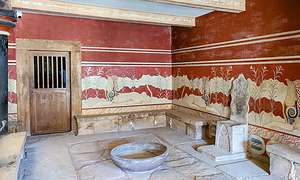 Throne RoomWhen excavating the ruins of Knossos, archaeologist Arthur Evans placed a copy of a restored relief bull fresco on the wall behind the columns, possibly using a bit of creative license, as historical accuracy as to its real appearance was not available.
Throne RoomWhen excavating the ruins of Knossos, archaeologist Arthur Evans placed a copy of a restored relief bull fresco on the wall behind the columns, possibly using a bit of creative license, as historical accuracy as to its real appearance was not available.
The grand rooms of the palace at Knossos were decorated with murals. Most of them were in such bad shape that they required extensive restoration, which may not have always been reliable. The frescoes are characterized by vibrant mineral colors (whites, reds, blues, yellows, and greens), applied to wet or dry plaster, with wide bands of geometric patterns serving as elaborate frames.
.thumbnail.jpg) Snake Goddess of KnossosWe entered one of the reconstructed buildings and found two frescoes which we were quite familiar with.
Snake Goddess of KnossosWe entered one of the reconstructed buildings and found two frescoes which we were quite familiar with.
The mural next to the window is the famous Toreador Fresco, which scholars believe represents a bull-leaping scene, a ritual game in which performers vaulted over a bull’s back. The fresco depicts a critical moment in the event. Two female figures (in white) are positioned at each end of the bull, while a male figure (in brown) throws himself into a somersault off of the bull’s back.
To the left of the Toreador Fresco is the “Ladies in Blue” fresco, named for its blue background. The three women are quite lavishly dressed and covered in jewels. They seemed quite modern-looking and fashionable for being painted over 3,500 years ago.
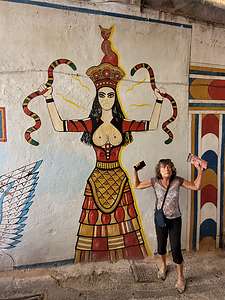 Modern day Snake GoddessNext, we entered the Throne Room, a chamber built for ceremonial purposes during the 15th century BCE. The murals on the surrounding walls were stunning. Note the creatures guarding the throne. They are griffins, legendary creatures with the body, tail, and back legs of a lion and the head and wings of an eagle.
Modern day Snake GoddessNext, we entered the Throne Room, a chamber built for ceremonial purposes during the 15th century BCE. The murals on the surrounding walls were stunning. Note the creatures guarding the throne. They are griffins, legendary creatures with the body, tail, and back legs of a lion and the head and wings of an eagle.
After visiting the actual site of the Palace of Knossos, we took a trip to the Heraklion Archaeological Museum, one of the best museums in the world for Minoan art. Here too we were greeted by some familiar favorites from our Art History books. Many of the artifacts here, including the murals, were moved here from the actual Palace site to better preserve them.
My all time favorite is the famous Snake Goddess, a female figure about 12 inches high, raising a snake in each hand. The snakes take up so much of the attention that you almost miss the cat sitting on her head. The revealing dress might seem shocking to modern viewers, but bare-breasted, buxom goddesses were worshiped in ancient civilizations. I believe they still are.
In many ancient religions, snakes are associated with earth deities and male fertility, and bared breasts suggest fecundity.
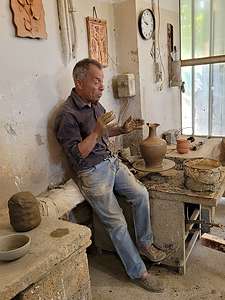 A master potterWe later came across some graffiti in an alleyway obviously painted by a student of Minoan Art. I couldn’t resist seeing what it might feel like to be a snake goddess.
A master potterWe later came across some graffiti in an alleyway obviously painted by a student of Minoan Art. I couldn’t resist seeing what it might feel like to be a snake goddess.
We did have one more activity today - a pottery demonstration by a master potter in a village of potters. He was pretty amazing. He slapped a lump of clay on his wheel, hit the gas pedal, and did magic. He made the vase rise, he made it widen, he gave it a spout, he made patterns in its side - and it took him less than 3 minutes. The end result was a beautiful amphora.
Next, he called for someone in the audience to try. No one budged as he was a pretty hard act to follow. Somehow I got suckered into doing it.
He plopped a blob of clay on the wheel for me and I pressed on the pedal. For a brief moment, I felt like Demi Moore in that scene in Ghost. Where was Herb when I needed him? That moment quickly passed.
.thumbnail.jpg) Not a master potterI had to keep remembering to wet my hands, because apparently that was important. I tried to do what he did and make my clay rise up high in some recognizable shape, but I think he gave me less clay than he had, because when I tried to raise it to the height he made his go, I ripped it right off the wheel.
Not a master potterI had to keep remembering to wet my hands, because apparently that was important. I tried to do what he did and make my clay rise up high in some recognizable shape, but I think he gave me less clay than he had, because when I tried to raise it to the height he made his go, I ripped it right off the wheel.
Without muttering a word, he took my blob, chucked it away, and put another one on my wheel. This time I tried to not go so high, but it soon began to wobble, somewhat out of my control. Not knowing how to get it back in control, I took my foot off the pedal and declared it a finished product. It didn’t look too bad, and I had accidentally created something resembling a spout.
At least I made the potter crack up.
I could definitely imagine how with some degree of skill, this could be very rewarding.
Day 3 - Gortyna ruins, old Venetian town of Vori, Phaistos ruins, and Matala Beach
.thumbnail.jpg) The Odeon at GortynaWe would be visiting two archaeological sites today, but Tassos warned us that they would be very different from Knossos in that they did not have the razzle dazzle of Arthur Evans’ creative reconstruction work. In contrast, they were left in their current excavation state.
The Odeon at GortynaWe would be visiting two archaeological sites today, but Tassos warned us that they would be very different from Knossos in that they did not have the razzle dazzle of Arthur Evans’ creative reconstruction work. In contrast, they were left in their current excavation state.
Our first stop was Gortyna, a place that has been inhabited since Neolithic times, but reached its pinnacle after it became the capital of Roman Crete around 67 BCE. At that time, there was believed to be as many as 100,000 residents.
Like every good Roman city, Gortyna had an Odeon, or theater. This one was originally built in the 1st century BCE. It was leveled in an earthquake and rebuilt by Trajan in the 2nd century CE.
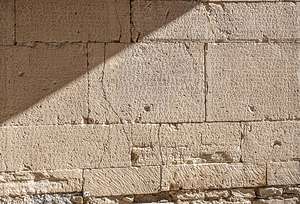 6th century BCE laws of Gortyna iThe covered, arched structure on the far side of the Odeon shelters Gortyna’s most important artifact: the 6th century BCE laws of Gortyna inscribed on massive stone tablets. These represent the oldest law code in the ancient Greek world, and cover many of the same issues we deal with today: property transfers, inheritance, marriage, divorce, and various criminal offenses. The 600 lines are written in a Dorian dialect.
6th century BCE laws of Gortyna iThe covered, arched structure on the far side of the Odeon shelters Gortyna’s most important artifact: the 6th century BCE laws of Gortyna inscribed on massive stone tablets. These represent the oldest law code in the ancient Greek world, and cover many of the same issues we deal with today: property transfers, inheritance, marriage, divorce, and various criminal offenses. The 600 lines are written in a Dorian dialect.
 (1).thumbnail.JPG)
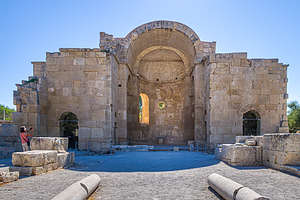 6th-century CE Byzantine Basilica of Agios TitosThe fact that Zeus chose to seduce Europa on Crete gives weight to the claim that the civilization of the European continent began on the island of Crete. In the 19th century, a colossal statue of Europa sitting on the back of a bull was discovered in the Odeon in Gortyna. Today, that statue, along with the Elgin Marbles from the Parthenon, are in the British Museum. I think it’s about time for the Brits to give the Greeks their treasures back.
6th-century CE Byzantine Basilica of Agios TitosThe fact that Zeus chose to seduce Europa on Crete gives weight to the claim that the civilization of the European continent began on the island of Crete. In the 19th century, a colossal statue of Europa sitting on the back of a bull was discovered in the Odeon in Gortyna. Today, that statue, along with the Elgin Marbles from the Parthenon, are in the British Museum. I think it’s about time for the Brits to give the Greeks their treasures back.
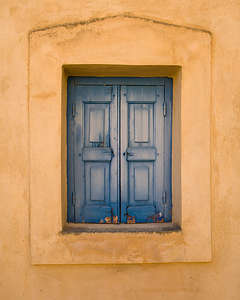 Venetian influenced architecture in VoriReturning to the real world (or the ancient one at least) from the world of mythology, we arrived at the very impressive, 6th-century CE Byzantine Basilica of Agios Titos, the finest early-Christian church in Crete. According to tradition, Gortyna was the first city in Crete to accept Christianity, so it became the seat of the first bishop of Crete, which was St. Titus, a disciple of the Apostle Paul.
Venetian influenced architecture in VoriReturning to the real world (or the ancient one at least) from the world of mythology, we arrived at the very impressive, 6th-century CE Byzantine Basilica of Agios Titos, the finest early-Christian church in Crete. According to tradition, Gortyna was the first city in Crete to accept Christianity, so it became the seat of the first bishop of Crete, which was St. Titus, a disciple of the Apostle Paul.
The conquest of Crete by the Arabs in 824 CE put an end to the history of ancient Gortyna. After the Byzantines recaptured the city from the Arabs in the 10th century, the church was rebuilt. All that survives today is the apse flanked by two side chapels.
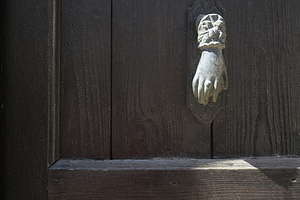
Venice controlled Crete from 1204 - 1669, so there is much Venetian influence in the town’s architecture.
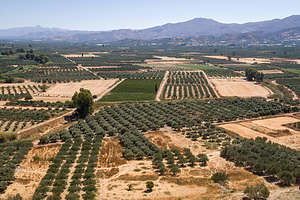 Messara Plain near PhaistosToday the village is classified as a “traditional protected village” by the Greek Ministry of Culture because of its collection of historical buildings, churches, homes, and way of life.
Messara Plain near PhaistosToday the village is classified as a “traditional protected village” by the Greek Ministry of Culture because of its collection of historical buildings, churches, homes, and way of life.
We visited the wonderful little Vori Ethnological Museum, which had a great collection of artifacts relating to cultural and traditional life on Crete - food production, farming, war, music, rural life, etc.
When we got to the ancient ruins at Phaistos, we had to use our imagination a lot more than at the partially reconstructed Palace of Knossos and even at Gortyna where there were several remaining intact structures.
.thumbnail.jpg) Ruins at Phaistos palace complexThe site has been inhabited since the Final Neolithic period (c. 3600-3000 BCE), but its greatest period of influence was from the 20th to 15th century BCE, during which time it, along with Knossos, was one of the most important centers of the Minoan civilization.
Ruins at Phaistos palace complexThe site has been inhabited since the Final Neolithic period (c. 3600-3000 BCE), but its greatest period of influence was from the 20th to 15th century BCE, during which time it, along with Knossos, was one of the most important centers of the Minoan civilization.
The palace of Phaistos was once the second largest palace in Crete, with Knossos being the largest. It was built on the most spectacular setting of all the palaces, high on a hill, overlooking the entire fertile Messara Plain, with Mr. Ida, Crete’s tallest mountain (8,058 feet) in the distance.
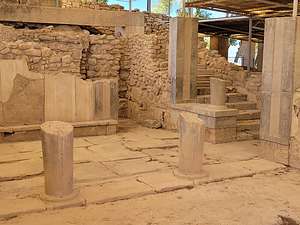 Queen's Apartment in the Phaistos PalaceWhile very few structures remain, we were able to see the building outlines and ground plan of the palace complex. The main courtyard, which still has its original pavement stones, looks out with unobstructed views over the Messara Plain.
Queen's Apartment in the Phaistos PalaceWhile very few structures remain, we were able to see the building outlines and ground plan of the palace complex. The main courtyard, which still has its original pavement stones, looks out with unobstructed views over the Messara Plain.
There were four deep circular pits, lined with stone walls, in the palace complex. These are known as kouloura, and similar ones were found at Knossos and other Minoan palaces. There are multiple theories as to what they were used for, such as garbage pits, cisterns for storing water, or, the most popular theory, a granary to store excess harvest.
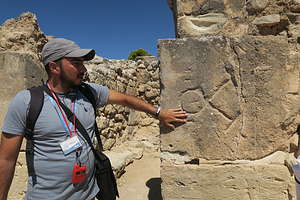
These rooms were lit by lightwells, a popular feature in Minoan architecture. They also had porticos and pier-and-door partitions which allowed sections of the room to be closed off. The floors and walls retain their original alabaster slabs and the walls are decorated with frescoes of plant motifs.
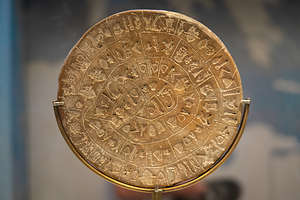 Phaistos DiskSome Linear A tablets were also found around the site. Linear A was the primary script used in palace and religious writings of the Minoan civilization. It was succeeded by Linear B, which was used by the Mycenaeans to write an early form of Greek. No texts in Linear A have yet been deciphered
Phaistos DiskSome Linear A tablets were also found around the site. Linear A was the primary script used in palace and religious writings of the Minoan civilization. It was succeeded by Linear B, which was used by the Mycenaeans to write an early form of Greek. No texts in Linear A have yet been deciphered
Amongst the many artifacts discovered at Phaistos was the mysterious Phaistos Disk, a disk of fired clay covered on both sides with a spiral of undeciphered symbols featuring 241 tokens, comprising 45 distinct signs. The symbols were made by pressing hieroglyphic “seals” into the clay, in a clockwise sequence spiraling toward the center of the disk. It has been dated to between 1850 and 1600 BCE. It is the only known sample of a hieroglyph-like writing system.
.thumbnail.JPG)
It is currently in the National Archaeological Museum in Athens, which we would get to see later when we returned to Athens.
We were about “scholared out,” so we were very much excited about our next stop - the famous Matala Beach on the southern coast of Crete, where we would have a seafood lunch at Petra and Volsalo, a great seafood restaurant right on the waterfront, followed by free time to explore the town or hang out at the beach.
.thumbnail.JPG)
Joni Mitchell lived in one during her time here. It was here that she wrote some of her most famous folk songs: “Beneath the Matala Moon” and “Carey” (a man with whom she had an affair while staying in Matala). Other celebrities that also came to Matala included Bob Dylan, Janis Joplin and Joan Baez.
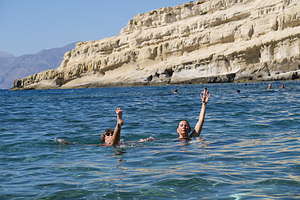
Today Matala is a thriving modern tourist destination, with very few remnants of their hippie past.
So, I guess we were now just some of those modern tourists here to enjoy the beauty of Matala Beach.
After lunch, we changed into our bathing suits in the restaurant restrooms and hit the beach for a few hours. Technically, we were now swimming in the Libyan Sea (which is still part of the Aegean). I don’t care what they call it, it was lovely.
Day 4 - Rethymno, Chania, and our overnight ferry back to Athens
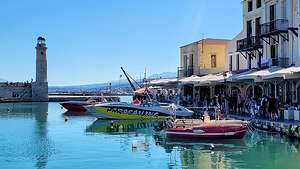 Rethymno HarborIt was our last day in Crete. This morning, as we did whenever we were moving on from one island to the next, we brought our luggage down to the hotel lobby, where it would be taken, stored in the bus, loaded on the ferry, and then magically appear in our next hotel room. It made us kind of nervous, but so far Tassos was 4 for 4. Just one more to go for a perfect score.
Rethymno HarborIt was our last day in Crete. This morning, as we did whenever we were moving on from one island to the next, we brought our luggage down to the hotel lobby, where it would be taken, stored in the bus, loaded on the ferry, and then magically appear in our next hotel room. It made us kind of nervous, but so far Tassos was 4 for 4. Just one more to go for a perfect score.
.thumbnail.JPG)
Our first stop for the day was the northern coastal city of Rethymno, one of the most well-preserved Venetian old towns on the island of Crete. Venice wasn’t just a brief visitor to this island, but rather they controlled it from the 12th - 16th century - a much longer period of time than the United States has been a country.
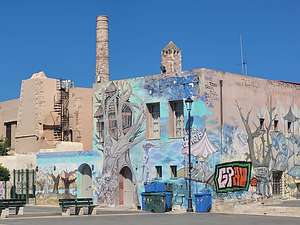 Street Art in Petichaki SquareThe architecture in the harbor and along the waterfront definitely reflected their Venetian past.
Street Art in Petichaki SquareThe architecture in the harbor and along the waterfront definitely reflected their Venetian past.
Another vestige of the Venetian occupation is Fortezza, an imposing medieval castle that stands on a hill looking down and once protecting the town.
In 1645, the Ottoman Empire took Crete from the Republic of Venice, and held onto it until 1897, so there is a lot of Turkish influence as well - often in the same building.
.thumbnail.jpg) Old Town RethymnoMany of the over 600 Venetian buildings have Turkish touches, such as latticework balconies (through which harem women used to keep tabs on street life without revealing themselves) and arched doorways with Turkish inscriptions.
Old Town RethymnoMany of the over 600 Venetian buildings have Turkish touches, such as latticework balconies (through which harem women used to keep tabs on street life without revealing themselves) and arched doorways with Turkish inscriptions.
Even the Neratze Mosque near Petichaki square was once a Venetian Church and then an Augustinian Monastery, before the Turks arrived in 1657, added a minaret and some balconies for praying, and transformed it into a mosque.
When Crete was later freed from the Ottomans, they turned it back into a Christian Church dedicated to Agios Nikolaos (the guardian saint of sailors), but the minaret remained and it never actually functioned as a church. Today, the Mosque houses the Municipal Odeon, run by the Rethymno Association for the Promotion of the Arts.
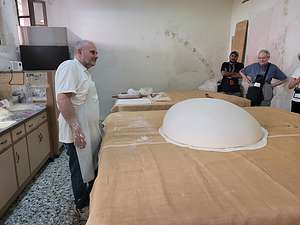 Baklava demonstrationWhile the waterfront with its numerous restaurants and cafes was definitely the main attraction, wandering through the narrow alleyways of the lovely Old Town was a close second.
Baklava demonstrationWhile the waterfront with its numerous restaurants and cafes was definitely the main attraction, wandering through the narrow alleyways of the lovely Old Town was a close second.
We got to see a demonstration of how baclava is made. The baker took a lump of filo and spread it so thin that it covered an 8’ x 8’ table. He then put a cloth over that and repeated the process several times. Then, he took one of the layers and flipped it in the air. It fell onto the table as a perfectly round dome. Not sure the purpose of this, but it sure was cool.
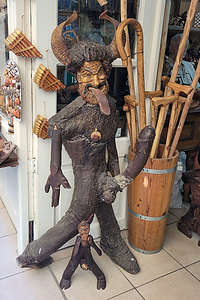 PriapusA Lot more stuff had to happen before this became baklava, but it was time for us to move on, but not before first buying a few samples.
PriapusA Lot more stuff had to happen before this became baklava, but it was time for us to move on, but not before first buying a few samples.
Afterwards, Herb and I went off on our own to wander the alleyways. We’re not really shoppers, and there was absolutely no room in my carry-on bag to fit any new additions, so we just window shopped. There were some pretty interesting objects for sale.

Another common souvenir were objects covered with large, wideopen blue eyes. They were everywhere - on posters, t-shirts, scarves, mugs, whatever. It’s called το μάτι (to máti) in Greek, and it is actually an “evil eye” – an amulet that is supposed to protect you from a curse that is said to be cast by envious people.
.thumbnail.jpg) My healthy yogurt energy bowlI bet the nearby wooden Priapus could use some protection from envious people.
My healthy yogurt energy bowlI bet the nearby wooden Priapus could use some protection from envious people.
However, there was one type of souvenir that pretty much is only found on Crete, specifically in the western prefectures of Heraklion, Rethymno, and Chania. That item is the Cretan dagger or knife.
Crete has a long tradition of “vendetta” and the men tend to act more “macho” than the rest of Greece. Cretan vendettas are a form of unwritten tradition, in which men take the law into their own hands. It is pretty much a family affair and emanates from the duty Cretans feel to protect their family honor. It is considered to be a great form of justice, almost pious, and the hatred and revenge between families is passed down from generation to generation. Knives were the weapon of choice. It still goes on today.
The knives were beautifully handcrafted and many even had poetry inscribed in the handle. I tried to convince Herb to get one as a souvenir, but he's not the vendetta type.
We ended our visit to Rethymno with lunch at the Lux Cafe on the waterfront, where I had a healthy yogurt energy bowl while Herb enjoyed his idea of a healthy power meal which included French Fries and a large beer.
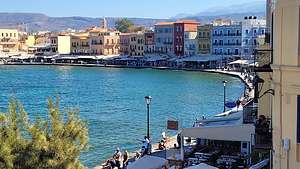 Chania's Venetian HarborTime to get back on the bus and get to our final destination on Crete - Chania, the 2nd largest city on Crete and the port from which we would be leaving later tonight.
Chania's Venetian HarborTime to get back on the bus and get to our final destination on Crete - Chania, the 2nd largest city on Crete and the port from which we would be leaving later tonight.
Chania, known for its 14th-century Venetian harbor, narrow streets and waterfront restaurants, is among the most picturesque towns in Crete. Due to the long occupation by the Venetians, its architecture has a vivid Medieval look.
However, like Rethymno, there is also a Turkish influence from when the Ottoman Empire booted the Venetians out and ruled for 250 more years.
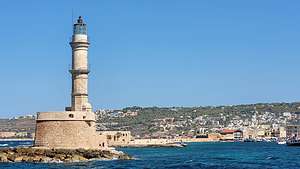 Chania LighthouseThis town certainly changed hands many times until it finally gained its independence from the Ottomans in 1898, formally becoming the Cretan State. Crete became part of Greece in December 1913.
Chania LighthouseThis town certainly changed hands many times until it finally gained its independence from the Ottomans in 1898, formally becoming the Cretan State. Crete became part of Greece in December 1913.
The lighthouse of Chania, which is the symbol of the city, stands at the end of a long stone pier jutting into the Venetian harbor. It was originally built by the Venetians in the 16th century.
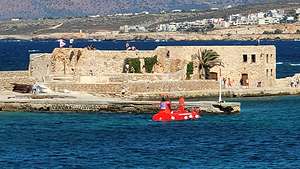 Firka Fortress being attacked by a Tourist submarineDuring the Turkish occupation, the lighthouse fell into disrepair and was eventually rebuilt between 1824 and 1832 in the form of a minaret. The reconstruction was done by Egyptian troops who were supporting the weakening Ottoman Empire against the rebellious Cretans.
Firka Fortress being attacked by a Tourist submarineDuring the Turkish occupation, the lighthouse fell into disrepair and was eventually rebuilt between 1824 and 1832 in the form of a minaret. The reconstruction was done by Egyptian troops who were supporting the weakening Ottoman Empire against the rebellious Cretans.
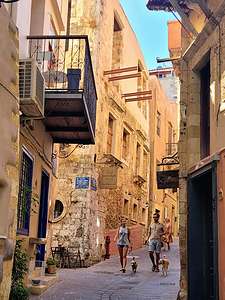 Old Town ChaniaHowever, the base of the lighthouse is still the original Venetian base, although the Lion of St. Mark, Venice’s patron saint, which was carved there has long gone.
Old Town ChaniaHowever, the base of the lighthouse is still the original Venetian base, although the Lion of St. Mark, Venice’s patron saint, which was carved there has long gone.
The Firka fortress dominates the other side of the harbor. It was built by the Venetians in 1629 to protect the harbor entrance from raiders. A chain could be connected from the fortress to the base of the lighthouse to close the harbor from invaders.
.thumbnail.jpg) Küçük Hasan Pasha MosqueI guess that didn’t work out too well, because the city fell into the hands of the Turks in 1645. The Turks used the fort as a barracks for their army and changed the name to “Firka,” which means a military division.
Küçük Hasan Pasha MosqueI guess that didn’t work out too well, because the city fell into the hands of the Turks in 1645. The Turks used the fort as a barracks for their army and changed the name to “Firka,” which means a military division.
We visited the Maritime Museum of Crete, next to the Firka Fortress, which houses an extensive collection of model ships, nautical instruments, paintings, historical photographs and war relics, and an impressive model of the fortified town and port when it was under Venetian rule. The material is classified chronologically, starting from the Bronze Age right up to the present.
.thumbnail.jpg) Sunset over Chania's Venetian HorborAfterwards, Herb and I wandered around the Old Town on our own, through its lovely Medieval looking alleyways.
Sunset over Chania's Venetian HorborAfterwards, Herb and I wandered around the Old Town on our own, through its lovely Medieval looking alleyways.
Eventually we wound up back on the waterfront near the Küçük Hasan Pasha Mosque. This was the first mosque built in Crete after it was declared an Ottoman province in 1646. After the Greco-Turkish population exchange in 1923, the mosque ceased to function and in 1939 its minarets were demolished. Today it is an exhibition hall.
While walking along the waterfront, we found one of the couples in our tour group sitting at a very well-placed table on the waterfront sipping wine. They invited us to join them and we readily accepted. Gradually, more and more of our group wandered by and soon there were eight of us enjoying the sun going down over the harbor.
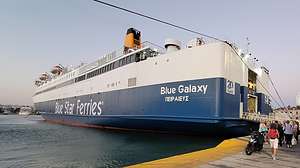 Our overnight ferry from Crete to AthensPretty nice way to end our time on Crete.
Our overnight ferry from Crete to AthensPretty nice way to end our time on Crete.
Now it was off to the Port of Chania, where we, and hopefully our luggage, which we had given up this morning, would board our 9-hour ferry back to Athens. We all had sleeper cabins, complete with bathrooms and showers, so hopefully it would be a very comfortable and uneventful passage.
Santorini
Monday, September 12, 2022 - 1:45pm by Lolo96 miles and 3.5 hours from our last stop - 2 night stay
Travelogue
Day 1 - Fira and Oia
.thumbnail.JPG)
As we approached, we saw what appeared to be snow or white icing atop the cliffs. However, the closer we got, the icing turned into the famous whitewashed, cubiform houses of Santorini.
A steep, zig-zaggy road led from the port up to the top. This or a cable car or a donkey are the only ways up to the village of Fira (also called Thera) - unless of course your group has its own private bus to transport you in comfort. Thank you Road Scholar.
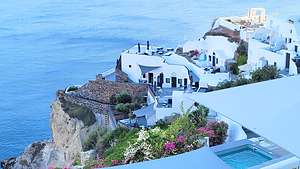 Oia's whitewashed cubiform houses carved into the cliffsBesides the crowds getting off the ferries, there were several cruise ships in the harbor that would be offloading thousands of tourists taking taxis or the cable car to the top.
Oia's whitewashed cubiform houses carved into the cliffsBesides the crowds getting off the ferries, there were several cruise ships in the harbor that would be offloading thousands of tourists taking taxis or the cable car to the top.
As a result, the port was packed with masses of people, but fortunately, our bus was there to greet us. We got on board and joined the dozens of other vehicles winding their way up the switchbacks to the top.
We would be staying for two nights in Fira, the picturesque capital of the island perched on the top edge of the caldera, 850 feet above us, with breathtaking views of the Aegean Sea.
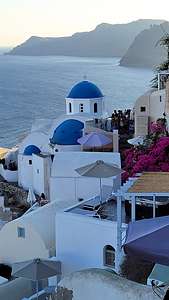 The beautiful white and blue-domed churches of OiaHowever, it was already 4:00 when we arrive on the island, so before checking into our hotel, our bus took us directly to the beautiful town of Oia, famous for its whitewashed houses and blue-domed churches carved into the rugged clifftops.
The beautiful white and blue-domed churches of OiaHowever, it was already 4:00 when we arrive on the island, so before checking into our hotel, our bus took us directly to the beautiful town of Oia, famous for its whitewashed houses and blue-domed churches carved into the rugged clifftops.
This was by far the most crowded village we had been to yet, and it didn’t help that a dramatic sunset was about to take place. It was shoulder to shoulder walking on the pedestrian way. The most popular spot to watch the sunset is by Oia Castle. The crowds there every evening are supposed to be insane, so we changed directions and started walking away from the sunset. I felt like a salmon swimming upstream, but we did seem to be leaving the crowd behind.
It sort of worked and soon we could actually breathe and take in the beautiful views of the whitewashed cubiform houses carved into the lava rock cliffs, overlooking the caldera below.
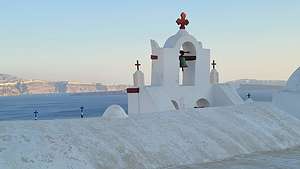 Bells, bells, bellsAnd then I found what I had been looking for - Oia’s famed whitewashed, cubiform churches topped with the famed blue-domes set into the cliffside.
Bells, bells, bellsAnd then I found what I had been looking for - Oia’s famed whitewashed, cubiform churches topped with the famed blue-domes set into the cliffside.
So why were there so many white and blue buildings in Greece? For aesthetics? Because they matched the flag of Greece? Actually, the answer to that is quite different. It is more out of necessity than aesthetics.
First, why the white?
In 1938, the dictator of Greece, Ioannis Metaxas, ordered all citizens to whitewash their homes to try to stop the spread of a cholera outbreak. Now, this might sound silly, but the whitewash contained limestone, which is a powerful disinfectant.
The white of the houses had the additional benefit of making them cooler during the hot Greek summers.
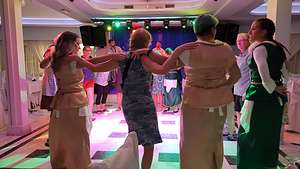 More Greek dancingOk, so what about the blue?
More Greek dancingOk, so what about the blue?
Because it was cheap and easy to make. Fishermen painted their windows and shutters with whatever was left over after painting their boats. The blue used for Greek island homes was made from a mixture of limestone and a cleaning product called “loulaki,” which was a kind of blue talcum powder most islanders had readily available at home. Therefore, blue paint was a practical choice.
When the military dictatorship took over Greece in 1967, they made white and blue mandatory, because they thought it would inspire patriotism.
These laws don’t exist anymore, but now many islanders make the personal choice to paint their homes blue and white, as it has become synonymous with Cycladic architecture.
That evening at dinner, we were treated to an evening of Greek dancers performing for us, and then encouraging us to join in the fun. Although hesitant at first, we all had a great time.
What a full day, and we hadn’t even checked into our hotel yet!
Day 2 - Akrotiri, relaxing by the pool, and wine tasting
.thumbnail.jpg) The donkeys of SantoriniThe next morning, our first in Santorini, we were awoken to the sound of tinkling bells. I ran out onto our balcony and quickly snapped a photo of a man leading a team of donkeys from the stone hut way off in the distance up into town. I found out later that these donkeys had a full-day of work ahead of them carrying tourists up and down the steep zig-zaggy paths from the port to the top of the caldera.
The donkeys of SantoriniThe next morning, our first in Santorini, we were awoken to the sound of tinkling bells. I ran out onto our balcony and quickly snapped a photo of a man leading a team of donkeys from the stone hut way off in the distance up into town. I found out later that these donkeys had a full-day of work ahead of them carrying tourists up and down the steep zig-zaggy paths from the port to the top of the caldera.
Today we had another very full day ahead of us: a field trip to Akrotiri and Wine Tasting. Fortunately, we did manage to squeeze a little down time relaxing at the pool somewhere in between all that. I'm not sure whose day would be more exhausing, ours or those donkeys we saw this morning?
.thumbnail.JPG)
This was the same volcano that blew away half of Santorini, changing it from a round island into a crescent-shaped one, with the harbor now being in the caldera.
.thumbnail.jpg) AkrotiriPrior to the volcanic eruption, the city of Akrotiri was very sophisticated. It had cobblestone streets, an extensive drainage system, and multi-story buildings with luxurious furniture and frescoes covering the walls. It had once been one of the most important Minoan urban centers and ports in the Aegean Sea.
AkrotiriPrior to the volcanic eruption, the city of Akrotiri was very sophisticated. It had cobblestone streets, an extensive drainage system, and multi-story buildings with luxurious furniture and frescoes covering the walls. It had once been one of the most important Minoan urban centers and ports in the Aegean Sea.
Preservation of the settlement is exceptional, making this one of the most significant archaeological sites in Greece.
.thumbnail.jpg) Chill time by the poolThe frescoes that once adorned the walls of the homes of Akrotiri before they were buried in volcanic ash were painstakingly removed and restored. They are now housed in the Prehistoric Museum of Thera, which we would visit tomorrow.
Chill time by the poolThe frescoes that once adorned the walls of the homes of Akrotiri before they were buried in volcanic ash were painstakingly removed and restored. They are now housed in the Prehistoric Museum of Thera, which we would visit tomorrow.
At one time, visitors were allowed to wander down and amongst the ruins, but now because of funding issues in hiring enough security personnel, we were confined to walkways above the ruins. The reason they have insufficient funding is that they lost their major sponsor, Yevgeny Kaspersky, one of the richest oligarchs in Russia, when he was sanctioned by the U.S. back in 2017.
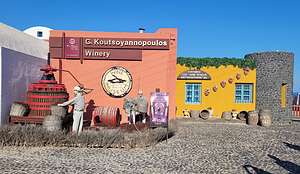 Koutsoyannopoulos Wine MuseumHowever, we still had a very interesting and educational experience being able to look down on the settlement from the walkways that surrounded the ancient settlement.
Koutsoyannopoulos Wine MuseumHowever, we still had a very interesting and educational experience being able to look down on the settlement from the walkways that surrounded the ancient settlement.
Back at the hotel, we were treated to a few hours of downtime, which we chose to spend at the hotel's lovely pool. We weren't the only ones, as we were soon joined by most of the rest of our tour group.
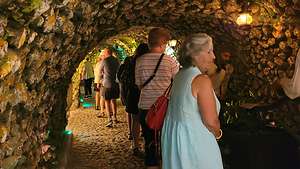 Wine cave in the Koutsoyannopoulos Wine MuseumLater that afternoon, we were back on the bus for one last activity that day - a visit the Koutsoyannopoulos Wine Museum. The winery has been a family business since 1870, when the Koutsogiannopoulos brothers wound up on Santorini island by mistake when they were blown off course by strong winds when trying to get to Syros. Apparently, they liked Santorini, because 150 years later the descendants are still making olive oil and wine here.
Wine cave in the Koutsoyannopoulos Wine MuseumLater that afternoon, we were back on the bus for one last activity that day - a visit the Koutsoyannopoulos Wine Museum. The winery has been a family business since 1870, when the Koutsogiannopoulos brothers wound up on Santorini island by mistake when they were blown off course by strong winds when trying to get to Syros. Apparently, they liked Santorini, because 150 years later the descendants are still making olive oil and wine here.
I have to confess to being a bit of a wine snob now that I live in Sonoma Valley. Their wines are very different from anything I have ever tasted. All I need to make me happy is a dry chardonnay with some texture.
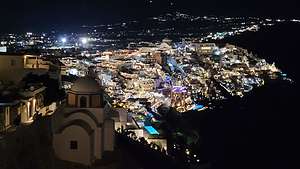 Fira at nightStill it was an awesome museum, nestled in a 300-meter long cave 8 meters below ground, with life size dioramas of the family's history in winemaking. It took them over 20 years to make this museum.
Fira at nightStill it was an awesome museum, nestled in a 300-meter long cave 8 meters below ground, with life size dioramas of the family's history in winemaking. It took them over 20 years to make this museum.
We got to sample four different kinds of wine in a room in the cave, but like I said, they just weren't what I like in a wine. That's not to say they weren't good. There were plenty of people in the winery bar that seemed to be enjoying them just fine.
Later on that evening, Herb and I decided to take a walk from our hotel to the pedestrian alleyways along the top of the cliffs above the caldera. It was nice and quiet, which was a pleasant surprise compared to the mobs we had experienced during the day. Looking out over the edge to the buildings built into the side of the cliffs with their lights ablaze was magical.
Day 3 - Prehistoric Museum of Thera and Paralia Perivolos (Black Sands Beach)
.thumbnail.jpg) The FishermanOur ferry to Crete didn't leave until 6:00 pm tonight, so we pretty much had another full day to enjoy Santorini.
The FishermanOur ferry to Crete didn't leave until 6:00 pm tonight, so we pretty much had another full day to enjoy Santorini.
First up was the Prehistoric Museum of Thera, a perfect follow-up to a visit to the ruins of Akrotiri yesterday. As I mentioned in my write-up about our visit the the Akrotiri Archeological site yesterday, the frescoes that once adorned the walls of the homes there before they were buried in volcanic ash were painstakingly removed and restored. The Prehistoric Museum of Therea is where they now reside for all to enjoy.
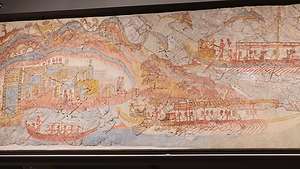 The FlotillaOne of my favorites is called "The Fisherman." I asked Herb to stand next to it so I could take his picture, because he too is a fisherman, but a security guard stopped us and said "no posing."
The FlotillaOne of my favorites is called "The Fisherman." I asked Herb to stand next to it so I could take his picture, because he too is a fisherman, but a security guard stopped us and said "no posing."
I later learned that Greeks think of their artifacts as sacred treasures and consider it disrespectful to pose with them. I think that is why when we were at the Acropolis, security guards started blowing their whistles and yelling to a girl who had a Greek flag wrapped around herself in front of the Parthenon to stop posing.
.thumbnail.jpg) Herb enjoying himself at Paralia Perivolos (Black Sands Beach)Another familiar frescro we saw in the museum was "The Flotilla," which depicted lots of boat activity in a harbor. The harbor must have been a different one than the one we pulled into the other day, because the volcanic eruption had not yet taken place, so there was no caldera yet. The Flotilla fresco showed that the residents of Akrotiri were very involved in commerce and trade with the rest of the Aegean world.
Herb enjoying himself at Paralia Perivolos (Black Sands Beach)Another familiar frescro we saw in the museum was "The Flotilla," which depicted lots of boat activity in a harbor. The harbor must have been a different one than the one we pulled into the other day, because the volcanic eruption had not yet taken place, so there was no caldera yet. The Flotilla fresco showed that the residents of Akrotiri were very involved in commerce and trade with the rest of the Aegean world.
.thumbnail.jpg) Lolo enjoying herself at Paralia Perivolos (Black Sands Beach)Tassos had a real treat for us today! - hint, he had told us to bring our bathing suits! Our bus brought us to the seaside village of Perivolos, in the southeastern corner of Santorini. We were then let loose with the instructions to return to the bus in 4 hours.
Lolo enjoying herself at Paralia Perivolos (Black Sands Beach)Tassos had a real treat for us today! - hint, he had told us to bring our bathing suits! Our bus brought us to the seaside village of Perivolos, in the southeastern corner of Santorini. We were then let loose with the instructions to return to the bus in 4 hours.
While some in our group chose to pass the time wandering through the town, six of us chose to spend it on Paralia Perivolos (Black Sands Beach) - great another chance to swim in the Aegean Sea and practice our synchronized swimming.
For 10 euro, we got two lounge chairs and a beach umbrella for the afternoon. Herb was quite happy with his situation, especially when he was delivered his very large Mythos beer.
I chose to spend my time swimming in the sea.
Then it was back on the bus to get to our 6:00 pm ferry to our final island - Crete.
Paros
Saturday, September 10, 2022 - 6:30pm by Lolo54 miles and 0.75 hours from our last stop - 2 night stay
Travelogue
Day 1 - Explore the town of Parikia
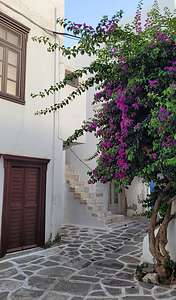 Alleyways of ParikiaAfter two nights on Mykonos, we boarded a 45-minute ferry to the island of Paros, a much more laid–back island than many of the others in the Cyclades. Tassos, our faithful guide, explained that it was “more authentic Greek,” as opposed to the international jet-setting feel of Mykonos, and that it was the place he would vacation to get away from the tourists.
Alleyways of ParikiaAfter two nights on Mykonos, we boarded a 45-minute ferry to the island of Paros, a much more laid–back island than many of the others in the Cyclades. Tassos, our faithful guide, explained that it was “more authentic Greek,” as opposed to the international jet-setting feel of Mykonos, and that it was the place he would vacation to get away from the tourists.
During our 2-day visit, we would explore three very different villages: Parikia, our home base, considered one of the most attractive villages in the Cyclades; Lefkes, a mountain village; and Naoussa, a fishing village.
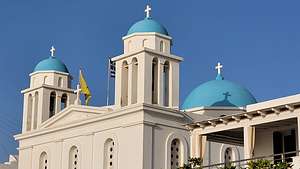 St. Nikolaos Holy Orthodox ChurchWe checked into our hotel, the Hotel Aegeon, which was charming and such a contrast to the over-the-top luxurious Mykonos Korali hotel. No private pool for us this time.
St. Nikolaos Holy Orthodox ChurchWe checked into our hotel, the Hotel Aegeon, which was charming and such a contrast to the over-the-top luxurious Mykonos Korali hotel. No private pool for us this time.
After a brief rest, we spent the afternoon and early evening with the group exploring the town. Parikia is the capital of Paros and considered to be one of the most beautiful villages in the Cyclades. I can certainly see why.
We spent a good part of the afternoon wandering through the lovely narrow stone alleyways of the town, admiring the colorful doors and beautifully colored flowers.
I knew we would be seeing blue-domed churches in Santorini, but I was delighted to discover our first, right along the waterfront. This lovely white church with three blue domes was called the St. Nikolaos Holy Orthodox Church. This is not the St. Nikolaos that brings presents on Christmas, but rather the guardian saint of sailors - very important to people living on a land totally surrounded by water. Sailors come to this church right on the harbor and leave tamatas or ex-votos (objects or paintings) in gratitude for a safe return from the sea.
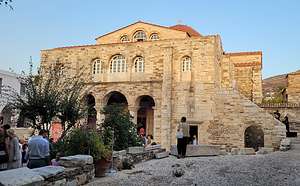 Church of Panagia EkatontapilianNext, Tassos brought us to a very different kind of church than we had seen so far - the Church of Panagia Ekatontapilian, an historic Byzantine pilgrimage church founded in the 4th century by Constantine the Great’s mother Helene.
Church of Panagia EkatontapilianNext, Tassos brought us to a very different kind of church than we had seen so far - the Church of Panagia Ekatontapilian, an historic Byzantine pilgrimage church founded in the 4th century by Constantine the Great’s mother Helene.
As the story goes, during Helene’s journey to the Holy Land to search for the Holy Cross, a storm brought her to Paros, where she made a promise to the Virgin Mary that she would build a church on the island if her quest was successful. According to church lore, she did in fact find the Holy Cross, so her son Constantine built this magnificent church and dedicated it to the Assumption of the Virgin.
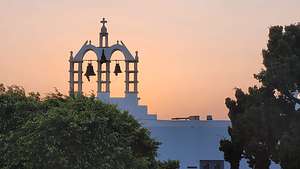 Church bellsThe name Ekatontapiliani means the Church with the Hundred Doors. According to tradition, the church has 99 doors and a secret door will open when the church of Hagia Sofia in Constantinople becomes Orthodox again.
Church bellsThe name Ekatontapiliani means the Church with the Hundred Doors. According to tradition, the church has 99 doors and a secret door will open when the church of Hagia Sofia in Constantinople becomes Orthodox again.
Helene would probably be quite surprised, and hopefully happy, to see what was going on in her church tonight. There were dozens of finely dressed people - the women stunning in their beautiful brightly colored fabrics, and heels that made my toes hurt just looking at them - gathered in front of the church for two separate celebrations of life - the welcoming of a new child (Baptism), and the joining of a young couple in marriage, which are two of the seven sacraments in the Greek Orthodox Church.
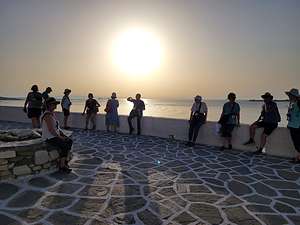 Tassos giving us a sunset lecture on the history of ParosOn our walk back to the hotel, we passed another one of Parikia's Orthodox Churches, this one much more modest than the last. It was that beautiful pure white that we had seen on Mykonos, and like many there, this one was topped with a number of bells.
Tassos giving us a sunset lecture on the history of ParosOn our walk back to the hotel, we passed another one of Parikia's Orthodox Churches, this one much more modest than the last. It was that beautiful pure white that we had seen on Mykonos, and like many there, this one was topped with a number of bells.
The ringing of bells is one of the most essential elements of an Orthodox church. Church bells are rung to both summon the faithful to services, as well as to express the triumphal joy of the Christian Church.
Of course, since we were a group of “road scholars,” Tassos gave us a lecture on the history of Paros. At least this time we got to watch the sunset over the Aegean while he was doing so. Herb, however, did lament the lack of a glass of wine to toast the end of another day.
Tomorrow would be another busy day, with three field trips: a visit to the lovely mountain village of Lefkes, a cooking demonstration in a family-owned hotel/restaurant, and a visit to the fishing village of Naoussa on the northern coast.
We were going to need a vacation after this vacation.
Day 2 - Lefkes, Cooking Demo, Naoussa, and my first swim in the Aegean
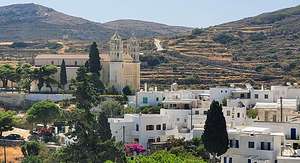 Lefkes with Agia Triada in backgroundThe next morning after breakfast at the hotel, we boarded our bus, which would take us around the island for the day. Road Scholar runs their tours very smoothly. On each island, we would have a bus, and the same bus driver, assigned to us for our entire time on that island.
Lefkes with Agia Triada in backgroundThe next morning after breakfast at the hotel, we boarded our bus, which would take us around the island for the day. Road Scholar runs their tours very smoothly. On each island, we would have a bus, and the same bus driver, assigned to us for our entire time on that island.
Our first stop was to Lefkes, a lovely mountain village nestled in the inland part of the Island’s mountainous region, surrounded by olive groves and verdant hills.
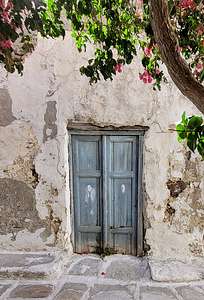 Alleyways of ParosThe town was built in the 17th century, as a protected enclave from the rampant piracy that plagued the Mediterranean during this time. At one point, it was even the capital of Paros. Its protected inland position also led it to become the farming epicenter of the island.
Alleyways of ParosThe town was built in the 17th century, as a protected enclave from the rampant piracy that plagued the Mediterranean during this time. At one point, it was even the capital of Paros. Its protected inland position also led it to become the farming epicenter of the island.
Now, it is a popular destination for those wanting to visit a more truly traditional Greek village, much quieter, peaceful, and real than many of the villages on the coast.
Once let loose, we did what we would come to love doing in every village we visited - stroll its lovely maze-like, stone alleyways, being surprised with something beautiful around every corner - colorful unique doorways, bright red bougainvillea flowers set against whitewashed buildings, and, of course, blue-domed churches.
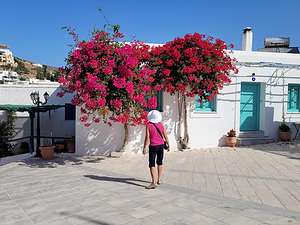 Lovely bougainvillea flowersThere was one particular whitewashed building fronted by two bright bougainvillea trees, that Tassos told us was very popular with Instagram "influencers," who dressed up to pose in between the bougainvillea trees.
Lovely bougainvillea flowersThere was one particular whitewashed building fronted by two bright bougainvillea trees, that Tassos told us was very popular with Instagram "influencers," who dressed up to pose in between the bougainvillea trees.
Besides the many small Orthodox Churches throughout the village, Lefkes is home to the second largest church on the island - Parikia’s Panagia Ekatontapilian, which we had visited yesterday being the largest.
Like the Parikia Church, the Agia Triada (Holy Trinity) is a 19th-century Greek/Byzantine basilica-style church, with two imposing marble bell towers dominating the structure. This church has a huge cultural importance to the people of Lekfes, and even Paros. The church is visible from pretty much everywhere in town.
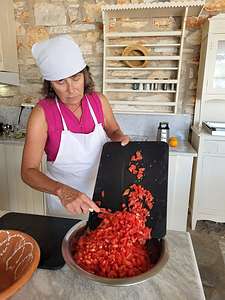 Cooking with MariaIt was getting near lunchtime, but rather than take the easy way out and just dine out at one of the tavernas in town (anyone could do that), we got back in the bus and drove to the Anezina Restaurant, in the village of Drios in the southeastern part of Paros, where we would have a cooking demonstration and get to make our own lunch. And maybe even dance a little.
Cooking with MariaIt was getting near lunchtime, but rather than take the easy way out and just dine out at one of the tavernas in town (anyone could do that), we got back in the bus and drove to the Anezina Restaurant, in the village of Drios in the southeastern part of Paros, where we would have a cooking demonstration and get to make our own lunch. And maybe even dance a little.
When we got to the Anezina Restaurant, we met Maria, our lively, funny cooking instructor for the day. She got us organized, and assigned us various vegetables, fruits, spices, meats, and cheeses to chop and dice for the next half hour.
I was put in charge of tomatoes, a very important part, along with olive oil and feta cheese, of Greek cuisine. I took my responsibilities seriously. Then, under the guidance of Maria, we somehow assembled and cooked our choppings into a delicious feast. It was very tasty and so so much fun.
Afterwards, to celebrate our successful feast, we did a traditional Greek folk dance, known as the kalamatianos, where we gathered in a circle, held hands, and kicked our feet (some of us somewhat randomly - not saying any names) as we went round and round, smiling and laughing the entire way. It was sort of like the Jewish hora.
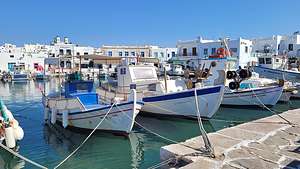 NaoussaWell fed and happy, we got back on the bus and were transported to the very northern end of the island to the fishing village of Naoussa. Tassos was certainly fulfilling his promise of showing us how varied the villages of Paros were.
NaoussaWell fed and happy, we got back on the bus and were transported to the very northern end of the island to the fishing village of Naoussa. Tassos was certainly fulfilling his promise of showing us how varied the villages of Paros were.
It too had its lovely narrow alleyways and sugarcube buildings fronted by brightly colored flowers, but the main attraction was the waterfront along the harbor, with its fishing boats bringing in their catch of the day and its many restaurants serving it.
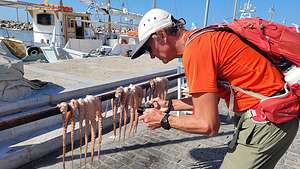 Fresh caught octopusThere was even some freshly caught octopus, dangling from what looked like a clothesline.
Fresh caught octopusThere was even some freshly caught octopus, dangling from what looked like a clothesline.
It’s no longer a quaint, quiet fishing village though, as it has definitely been discovered by tourists and has become one of the more popular destinations on Paros, with swanky international cuisine, chic cocktail bars, and expensive designer clothing boutiques.
 Catch of the dayWe watched the same thing happen to our favorite island, Martha Vineyard, in the states. There’s a lot more money selling art and clothing than tackle and bait.
Catch of the dayWe watched the same thing happen to our favorite island, Martha Vineyard, in the states. There’s a lot more money selling art and clothing than tackle and bait.
Still, it was a lovely town to wander through.
It had been quite a busy day - two very different types of villages on two different sides of the island and a cooking demonstration in between.
Tonight was free time to spend on our own back in Parikia. I very much wanted to walk to one of the beaches along the waterfront and swim in the Aegean for the first time.
It was already getting near sunset, so rather than walk to one of the better known ones a mile or two away, we just went straight down from our hotel to the waterfront and settled ourselves on a beach overlooking a windmill set on a point, with the sun setting right behind it.
.thumbnail.jpg) First time in the Aegean SeaThe problem was, I didn’t really think we were going to swim, so I had my bathing suit in my backpack rather than on my body.
First time in the Aegean SeaThe problem was, I didn’t really think we were going to swim, so I had my bathing suit in my backpack rather than on my body.
Determined, however, I hid behind a tree and quickly, yet not too gracefully slipped into it. Herb declined to do the same and said he'd rather sip the beer he had packed in his backpack and spectate.
His loss. The water was quite shallow and the beach rocky, so I sort of had to crawl into water deep enough to technically “swim.” It was warm and delightful, and highly scenic.
The only problem now was having dinner in a wet bathing suit. Still worth it.
Mykonos and Delos
Thursday, September 8, 2022 - 10:45am by Lolo114 miles and 5.5 hours from our last stop - 2 night stay
Travelogue
Day 1 - Arrival on Mykonos, enjoy our private pool, and stroll through Old Town and Little Venice
 Our early morning ferry to MykonosAs part of our education, Tassos (our tour guide) felt it important that we learn the modern culture of the various islands in the Aegean, and how they have evolved differently. So, during our tour we would visit four islands - Mykonos, Paros, Santorini, and Crete and immerse ourselves in each of their histories and cultures. The Road Scholar tour was not a cruise, but rather we would be taking ferries from island to island.
Our early morning ferry to MykonosAs part of our education, Tassos (our tour guide) felt it important that we learn the modern culture of the various islands in the Aegean, and how they have evolved differently. So, during our tour we would visit four islands - Mykonos, Paros, Santorini, and Crete and immerse ourselves in each of their histories and cultures. The Road Scholar tour was not a cruise, but rather we would be taking ferries from island to island.
The first island on our list was Mykonos - and what a place to start! For more than 50 years, the island of Mykonos has been one of the most popular destinations for the rich and famous - the most famous of which was Jacky Kennedy. We were very ready to immerse ourselves in this culture.
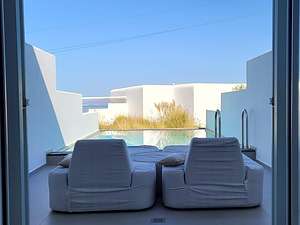 Our private poolMykonos was a 5 ½-hour ferry ride from Athens, so we received a wake up call at 5:00 am to catch the 7:00 am ferry from Athens to Mykonos, thereby allowing us to have almost a full day on the island.
Our private poolMykonos was a 5 ½-hour ferry ride from Athens, so we received a wake up call at 5:00 am to catch the 7:00 am ferry from Athens to Mykonos, thereby allowing us to have almost a full day on the island.
Our bus was waiting for us at the port to deliver us up the steep narrow road to our home for the next 2 nights - the lovely Mykonos Korali Hotel. The logistics were perfect. Our luggage was taken from us at the Acropolis Select, stored on the ferry, and then magically waiting for us in our hotel room upon arrival.
When we arrived at the hotel, we were brought to our room by a staff member who felt the need to explain how things worked - like the well-stocked mini-fridge. Herb was really hoping for a nice view behind the closed curtains, but when she opened them, we saw this lovely private pool, just for us. We felt like we had chosen the right door on Lets Make a Deal. I knew where Herb would be spending the rest of the day.
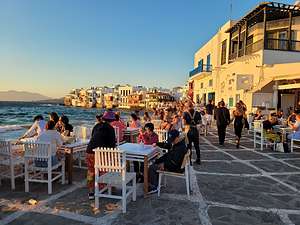 Old Town MykonosThis was definitely not our usual style of travel - usually I’m sleeping in the back of our 4Runner in some remote wilderness. But this was after all an educational tour, so I was willing to learn to immerse myself in the modern culture of Mykonos - and, of course, the pool.
Old Town MykonosThis was definitely not our usual style of travel - usually I’m sleeping in the back of our 4Runner in some remote wilderness. But this was after all an educational tour, so I was willing to learn to immerse myself in the modern culture of Mykonos - and, of course, the pool.
After a two hour refreshing break, we joined our tour group to take our tour bus back down to Old Town Mykonos to wander along the waterfront. We took our tour bus because although the walk wasn’t very far, it was down a steep, narrow road with no shoulder - and did I mention that Greek drivers are a little crazy.
.thumbnail.jpg) Alleyways of Old Town MykonosThe Old Town (called Chora by locals) is a traditional Cycladic Village, with mazes of narrow streets, cubic whitewashed houses, colorful doorways, bougainvilleas, and small white churches. And of course, the famous 16th century windmills, which I will get to later.
Alleyways of Old Town MykonosThe Old Town (called Chora by locals) is a traditional Cycladic Village, with mazes of narrow streets, cubic whitewashed houses, colorful doorways, bougainvilleas, and small white churches. And of course, the famous 16th century windmills, which I will get to later.
We walked along the lovely waterfront, lined with boutiques and restaurants, before heading into and getting lost in the maze of stone alleyways. It was hard to get too lost though, because eventually we always popped out along the waterfront.
One particularly nice section of Old Town was Little Venice, officially known as Aléfkántra. Its brightly painted former fishermen’s houses with balconies jutting out over the sea provided a colorful backdrop to the bustling bars and restaurants that line the waterfront between it and the windmills.
 Church of Panagia ParaportianiThe town became more and more crowded as sunset approached, and I can understand why. It was hard to pick where to be for the best view of sunset.
Church of Panagia ParaportianiThe town became more and more crowded as sunset approached, and I can understand why. It was hard to pick where to be for the best view of sunset.
We decided on the windmills, so we set off along the waterfront, stopping first to photograph the beautiful pure white Church of Panagia Paraportiani, one of the most photographed churches in the whole world.
The Church, which dates back to the 1400s, is considered a perfect example of Cycladic architecture. Its asymmetrical shape is due to the fact that it is not just one church, but rather a series of five tiny churches squeezed together - four below and one on top. At the center is the church of Agios Efstathios, surrounded by the churches of Agia Anastasia, Agios Anargyros, and Agios Sozon, and with the Church of the Virgin Mary standing out at the top with a dome.
.thumbnail.jpg) Iconic windmills of MykonosWe hurried to get to the iconic windmills of Mykonos, just in time for sunset. I have never seen windmills like this before. These five windmills, collectively known as “Kato Miloi,” were built by the Venetians in the 16th century to mill the grain produced on Mykonos, which was then distributed throughout the Aegean and even to Asia.
Iconic windmills of MykonosWe hurried to get to the iconic windmills of Mykonos, just in time for sunset. I have never seen windmills like this before. These five windmills, collectively known as “Kato Miloi,” were built by the Venetians in the 16th century to mill the grain produced on Mykonos, which was then distributed throughout the Aegean and even to Asia.
No longer milling grain, the windmills are now an extremely popular and highly photographed tourist destination. We had to jockey for a position to take a photograph.
It was time to find our group again to take our bus back up the short windy hill to our hotel. Herb and I couldn't resist a glass of wine out on or poolside lounge chairs before calling it a day - and a wonderful day it was at that.
Tomorrow we would take a day trip to the island of Delos.
Day 2 - Side Trip to Delos
.thumbnail.JPG)
Although Delos is only 5 kilometers long, it has served an extremely important role in Greek history.
Before our trip, I knew Delos as the birthplace of two very important Greek divinities: Artemis, the goddess of wild animals, the hunt, chastity, and childbirth; and her brother Apollo, the god of music, poetry, healing, and prophecy. As a result, it was an important religious and cultural center from the 3rd millennium BCE right up to the 5th century BC.
.thumbnail.jpg) Sanctuary of ApolloHowever, what I didn’t know is that it was also a thriving commercial center, with an estimated 750,000 tons of merchandise passing through the port each year during the first century BC. During that time, the population of this tiny island was 30,000. Today it is 14.
Sanctuary of ApolloHowever, what I didn’t know is that it was also a thriving commercial center, with an estimated 750,000 tons of merchandise passing through the port each year during the first century BC. During that time, the population of this tiny island was 30,000. Today it is 14.
We began our exploration of the island in the commercial section of the island where many rich merchants lived. There were streets, rich houses with mosaics, and even a theater district. The island was inhabited until the 7th century CE.
Separated from the commercial center was the Sanctuary of Apollo, the religious center of the island. We passed the Terrace of the Lions, a series of four lions carved in the 6th century BCE of marble from the nearby island of Naxos. Their purpose was to guard the sacred area. These lions are actually reproductions. The original ones are in the Archaeological Museum on the island.
.thumbnail.jpg) Terrace of the LionsFurther along, we came across some Amphoras near a stone wall. Amphoras were often used to contain funeral offering for the deceased, or in this case, probably an offering to Apollo
Terrace of the LionsFurther along, we came across some Amphoras near a stone wall. Amphoras were often used to contain funeral offering for the deceased, or in this case, probably an offering to Apollo
And, of course, there was the inevitable phallus (although this one was a bit broken), a common symbol of fertility in Ancient Greece. The rooster was also sacred to the ancient Greeks and symbolized vigilance.
.thumbnail.jpg) Phalluses were a common symbol of fertilityWe were running out of time before our ferry (the last one of the day) was scheduled to leave, so unfortunately we would not have time to hike up Mount Knythos, the small mountain, and the highest point on Delos, that was calling out to us. This mountain is the mythological birthplace of Apollo and Artemis.
Phalluses were a common symbol of fertilityWe were running out of time before our ferry (the last one of the day) was scheduled to leave, so unfortunately we would not have time to hike up Mount Knythos, the small mountain, and the highest point on Delos, that was calling out to us. This mountain is the mythological birthplace of Apollo and Artemis.
That was the tough part about being on a tour. Everything is pretty tightly scheduled so you don't have as much flexibility.
After we got back to our hotel on Mykonos, we had a bit of free time to relax and a tough choice to make - swim in our private pool or do laps in the larger hotel pool, which we had to share with other people. Good God. We were getting spoiled. Wanting to get some well-needed exercise, we chose the larger pool.
We didn't have too much time though because we were scheduled to meet at 7:00 on the hotel's outdoor reception area for a lecture on the challenges that modern Greece has faced in the last two centuries - we were Road Scholars after all.
This was where Herb almost mutinied for the first time. We love sunsets, and we love a nice glass of wine to watch the golden light before the sun dips below the horizon. The problem was that Tassos' lecture, which was held on a lovely outdoor patio, coincided with sunset. I could see Herb getting antsy as the sky began to take on a golden glow. Finally, unable to contain himself, he excused himself and went to retrieve two wines from our hotel room’s mini-fridge, so we could listen, while having a proper cocktail hour while watching the sunset. Maybe Herb wasn’t “scholar” material afterall.
Day 3 - Walk down to Old Town Mykonos and ferry to Paros
 Little VeniceToday we would catch a morning ferry to the island of Paros. However, I realized that I had enough time to walk down to the Old Town to photograph it in the morning light before the crowds started filling up the streets.
Little VeniceToday we would catch a morning ferry to the island of Paros. However, I realized that I had enough time to walk down to the Old Town to photograph it in the morning light before the crowds started filling up the streets.
I asked Herb if he wanted to join me, but he was already sitting with a cup of coffee in his bathrobe on the lounge chair by our private pool. In other words, he wasn’t going anywhere. I think I was going to have to carry him kicking and screaming off this island.
So, off I went alone down the narrow, winding, shoulderless road to Old Town. It was so lovely - no crowds, just local proprietors getting ready for the onslaught that would later occur.
I wandered through Little Venice, along the quiet stone alleyways, and back to the iconic old windmills. It was so peaceful and serene.
Mykonos had been a lovely stop. Now onto Paros.
